Here gathered a series of texts published around the net where Brad Mehldau talk about "Creativity in Beethoven and Coltrane".
Precious reading for those seriously interested in Music.
Precious reading for those seriously interested in Music.
Part One: Taking Stock and Shoring Up in Opus 95
How do we map the total creative output of a musician over his or her lifetime? One approach is to divide that output into distinctive periods. An example is the well-known three-period appraisal of Beethoven's music: There is an early period where he is imitating, a second period of maturation in which he finds his own voice, and a third later period in which Beethoven transcends his own voice, forging yet another style. Does this method have any currency when it is applied to an improvising jazz musician?There is potential folly in the practice of demarcating supposed creative periods. As a critical venture, it is retrospective, drawing its lines through a body of work that already exists as a totality. It is by nature anti-holistic and might mutilate the integrity of that work by severing the continuity that exists throughout a musician's lifetime. In short, this approach will be fraught with inconsistency and will have an arbitrary aspect.
Nevertheless, by demarcating different periods of creativity and assigning a specific quality to each one, we are trying to give form to that shapeless totality of a musician's total output. Once a preliminary form exists, the real venture of criticism may begin in earnest, and that is to fashion a credible narrative that corresponds to the musician in question.
The power of this narrative, like all narrative, rests on its ability to represent the passage of time. Throughout a novel, for example, we observe the protagonist. Events befall him that effect a change within him, or he elects to change his surroundings. This process of change is contingent on the movement of time, as is another key element of any narrative: memory. The memory of the protagonist will affect his decisions, and in turn, the memory of the reader will allow him to understand the protagonist more deeply. Ultimately, the role of criticism should be the same as the role of great fiction, to a point: By placing its subject in a temporal context, it allows the reader/listener to empathize with that subject more closely as he reflects on how time and its vagaries have affected him as well. There is an opening between the subject and his or her reader, and a communion is possible that can span centuries.
So we shatter the oneness of a musician's total work when we split it into periods, destroying the organic unity that existed, but this shattering is a creative act as well because it allows us to begin constructing a story about that musician. Time begins in this moment of rupture.
To the extent that we are telling a story about creativity, one great recurring theme will be mortality. Every time a musician can create, he escapes, momentarily, his mortality. The much-feared drying up of creative juices is a metaphor for one's demise. The passage of time is central to the narrative here because creativity is not endlessly doled out from above; on the contrary, it is often cruelly finite. Musicians, artists, and the like are given gifts along the way—most commonly earlier in their output—but as time passes, the gods are more fickle. Something truly creative must increasingly be coaxed out; it does not flow freely.
The narrative of Beethoven's creative output, with its exalted third period, has an Odyssean hue. Through ruthless cunning and sheer will, Odysseus vanquishes his foes and survives to return home as victor. He has completed his circular journey and is once again home, but now he possesses a great amount of knowledge and wisdom that he gained during his adventures.
Beethoven likewise returns in his later period to a simple, paired down form of expression that he never would have attempted in his earlier years. In his last string quartet (F Major, Op. 135), the music is unfettered and light in the opening Allegretto movement and touched by a new kind of grace in the slow third movement. In one sense, the lightness and grace evoke the Classicism of Beethoven's predecessors—gone is the Sturm und Drang of his early and middle periods—yet there is something new here: The composer has attained this classical symmetry once again, after a great struggle. A new, strange kind of peace breathes in this music, but it is not a peace that has been granted; it is a peace that has been won.
In comparison with the epic scope of other late string quartets, like Op. 131 or Op. 132, Beethoven's very last strikes us with its brevity and economy. I remember my first exposure to the late quartets. I listened to them in the order of opus number, eagerly awaiting the last one, and when I first heard it, I was puzzled and a little disappointed—it seemed like a dwarf among giants. The characteristic expansiveness was absent.
Beethoven's style had grown more expansive in his middle period, and that trend continued during his third period. But Op. 135 usually runs no more than 25 minutes in performance, compared with the 45-minute length of another late quartet, Op. 132. We often see this kind of expressive retraction as a welcome outcome of aging: We grow tired of our own long-windedness—and that of others—as the years pass, so we learn to express something more quickly and succinctly. Hopefully, though, our ideas do not become dulled.
 This is certainly not the case with one of my favorite of Beethoven's string quartets: Op. 95, often subtitled "Serioso." In this quartet, it is as if all the kinetic energy of one of Beethoven's great extended middle-period works has been squeezed by a vice grip into something more compact: Because it is shorter in length, the gravitational force of the music has intensified. There is no fat on this quartet, only lean muscle. The "Serioso" still inhabits Beethoven's second period proper, but it can be seen as a transitional work between the second and third periods. I imagine, in my own narrative about Beethoven, a process of taking stock and shoring-up before a descent into deeper waters.
This is certainly not the case with one of my favorite of Beethoven's string quartets: Op. 95, often subtitled "Serioso." In this quartet, it is as if all the kinetic energy of one of Beethoven's great extended middle-period works has been squeezed by a vice grip into something more compact: Because it is shorter in length, the gravitational force of the music has intensified. There is no fat on this quartet, only lean muscle. The "Serioso" still inhabits Beethoven's second period proper, but it can be seen as a transitional work between the second and third periods. I imagine, in my own narrative about Beethoven, a process of taking stock and shoring-up before a descent into deeper waters. At the opening of the "Serioso," Beethoven presents his motivic material with no fanfare or introduction:

There is no preparation for the jagged, almost brutal theme that begins the piece, and the effect is violent. What follows immediately is equally violent. The tonic F-minor tonality has barely strutted on the stage when it is brashly yanked away by the dominant:

A quick battle between tonic and dominant ensues. The dominant tonality has the last word in bar 5, ending unquestionably on a unison C. This gives the listener an uncomfortably asymmetrical pair of phrases in the opening bars of the piece—a two-bar opening phrase and a three-bar reply. It is clear that this is not just an argument—it is already a shouting match. The dominant unison at bar 5 is that extra bit of screaming—"And don't you forget it!"—that is meant to eradicate any further reply from the tonic. These opening five bars are shocking and jarring, but there is also humor. The lopsided rejoinder in bars 3–5 is uncouth, disregarding the Classical ideal of symmetrical phrase length immediately at the beginning of the piece, with no explanation. The F-minor tonality initially argues its point forcefully but with restraint; what follows is simply screaming back for a longer duration.
There is a counterintuitive logic underlying all this feisty rhetoric. The opening phrase in bars 1 and 2 is scalewise and thus melodic in character; the next phrase is full of octave leaps and goes out of its way to not be melodic, with its repeated Cs. It is essentially a harmonization and nothing more. In fact, it looks strangely like an ending cadence—a kind of anti-cadence that ends on the dominant. A basic principle of harmony—one could say the basic principle of harmony for several centuries now—is that the dominant leads to the tonic. By strongly differentiating the shapes of these two phrases, though, Beethoven has cast the tonic and dominant as adversaries. They are like magnets that repel instead of attract each other.
This gesture is a prelude to Beethoven's later genius. His early- and middle-period innovations are largely expressive—the stormy introduction of the "Pathetique" Sonata, the mysterious opening movement of the "Moonlight" Sonata, or the great funereal slow movement of the "Eroica" Symphony are obvious examples among many. Beethoven was expanding the expressive potential of music, pushing it out of the 18th century court and giving the audience a richer, more intense emotional experience. The innovation in Op. 95, by contrast, is less overtly felt but more deeply subversive. Beethoven is calling into question a deep, founding principle of tonality. The music is deconstructive, not destructive—he is not doing away with the rules of tonality or turning them outright upside down; he is asking us to look differently at something that we always see.
Violence is a driving theme of this quartet. Beethoven willfully thwarts the development of his motifs, striking them down at once. But when he shuts down ideas like this, there is logic involved. The gesture in bars 3–5 is no mere stupid blow; as forceful as it is, it is a rejoinder to the initial motif. It forces Beethoven to essentially begin the piece again, as he does here at bar 6:

The theme redresses itself in the warm key of G-flat major. In the opening, it was heard in stripped down, unharmonized octaves, which gave it a raw, brutal quality. This time, it is heard only in the cello, less threateningly, and is harmonized sweetly by the other strings above. It welcomes us away from the battle, promising reconciliation and a brand new start with its ascent upwards by a half step. This, coupled with the shift to a major mode, sends us a message: "Here is that theme for you, new and improved, easier on the ears and less jarring!"
We cannot properly speak of an actual modulation to G-flat major—there has been no voice leading between bars 5 and 6. This shift to another tonal center without preparation for a surprise effect had long been a favorite device of Beethoven's, for example, at the beginning of a development section. Here though, the stark juxtaposition between F minor and G-flat major has a specific meaning. It tells us right away what this piece will be about: opposition between poles, followed by resolution, followed by more opposition.
The resolution is always provisional and temporary. The sunny mood at bar 6 is over almost as soon as it begins. The listener feels G-flat major as a new tonic because Beethoven gave us the opening theme again. This is subterfuge, though. In bar 10, one more time, the dominant attacks again, with a pathos and subtlety that was absent in its first attack on the tonic seconds earlier; this mood change correlates to the more lyrical quality of theme's statement at bar 6. We see that G-flat major was ill-fated as a tonic: The dominant usurps that fleeting status through voice-leading at bars 8 and 9 and recasts G-flat major in a mere Neapolitan role—as a flatted second chord which must lead to the dominant. This is a completely legitimate move, well within accepted practice already for a good century, but it is downright sneaky here because G-flat had appeared to be the new tonal center seconds earlier.
The Neapolitan chord—built from the root of the flatted second degree of the scale that constitutes a given tonality; in this case, the G-flat of F Minor—is a more chromatic alternative for the subdominant in a progression that will continue to the cadential dominant and then resolve. But Beethoven withholds resolution here—the dominant is allowed to revel in its victory at bar 10 for the next several bars. So, for the second time, we have the strange feeling of anti-cadence: we have arrived at the dominant as if it were a kind of tonic, and we can go no further. The Neapolitan progression has been used partially and its original function is now eradicated. What we have now is a similar struggle between two tonalities like the opening of the piece, but one that sounds particularly sinister because they are a tritone apart. We see this simply if we harmonize those tonalities into simple triads and play them back-to-back a few times:

The tritone relationship is one of equidistance within the chromatic scale: If I travel upwards or downwards from either triad in stepwise motion, I will arrive at the other triad in the same amount of steps. This directionless spatial relationship has a corollary effect on our ears: It is the sound of utter instability. Because they are equidistant from each other, neither triad wins over our ears as a tonic. In the early 20th century, as the tonal hierarchy gives way and we approach complete chromatic saturation—in the music of Richard Strauss and in Arnold Schoenberg's earlier works, for example—this kind of tritone relationship is normal. Or rather: It becomes a normative trope for everything that is not normal, and often denotes something sinister or scary. It becomes a cliché in film soundtracks, heard as the enemy's army marches toward us. Beethoven anticipates the sound of 20th-century instability, but he achieves that by thwarting and subverting conventional principals of harmony that had already existed—principals that he had reflected on, at this later point, for quite some time.
In his book about Schoenberg, the pianist and music scholar Charles Rosen comments on true originality—the kind that comes around only a few times each century—and distinguishes it from mere individuality:
Originality requires the exploration of a self-created universe coherent and rich enough to offer possibilities beyond the development of an individual manner. An individual style built upon the placid acquiescence in a disintegrating language is stamped, too, with a peculiar character; it is reduced to the exploiting of a limited set of mannerisms[...]
Beethoven is his own alpha and omega; when he subverts, he is subverting a style that he himself mastered. With some quick unpeeling, we always find that mastery. This is subversive and authoritative at once, and it is why no easy reduction of Beethoven is possible, as it is more readily with much of the music of the 20th century, which was never harmonically tethered in the first place. Rosen notes that Schoenberg spoke with contempt about contemporaries of his who composed "pseudo-tonal" works—those who acquiesced to that "disintegrating language" of tonality. Schoenberg took tonality—or more specifically, the guiding principles of Western tonality that began in the Renaissance and developed up through his own day—at least as seriously as Beethoven, and recognized that a limit had been reached.
Limitation, and how to bypass it or transcend it: In the narrative about Beethoven's creative mortality, he has won a victory in Op. 95 over the limitations of his genre, not by ignoring them, which would lead to nonsensical expression. Instead, he reexamines his—and our—assumptions about these limiting principles. Thus, the stage is set for Beethoven's compositional endgame strategy in his exalted third period, when he will return to seemingly conventional, at times even banal material, and then transform it into something the world had never heard before, and still shocks our ears today.
So much drama takes place in the first 15 seconds of Opus 95 that by the time the more lyrical second subject of the exposition starts, a bloody battlefield already stands before us. The expository material of the first movement unfolds through a dialectical process rooted in the sonata-allegro form, but there is a merciless quickening to that process, which makes the music sound perpetually modern.
That quickening calls to mind the writing style of the 20th-century German thinker, Theodor Adorno. In his Negative Dialectics, a sentence will fold back into itself like the thematic material of Beethoven; the act of positing and answering is wrapped in a single, compressed bundle. Adorno is critiquing the dialectical tradition of Kant and Hegel; the first movement of Beethoven's Op. 95, likewise, is a critique of the sonata-allegro form found in the high Classicism of Mozart and Haydn, and his own earlier works. In both Adorno and Beethoven, there is a disavowal of complacent thought, or perhaps they have unavoidably arrived at this impasse. This sentiment is familiar in the 20th-century context—there is a rejection of the expressive devices of the past and often an accompanying despair. That implies defeat or a Beckettian endgame, but in Beethoven's case, his new, leaner, and meaner form of expression is a stepping stone to creative victory. For when he turns again to the more expansive approach in his later works, it will be even more audacious and more profound than what he had previously achieved.
Part One: Taking Stock and Shoring Up in Opus 95
Originality requires the exploration of a self-created universe coherent and rich enough to offer possibilities beyond the development of an individual manner. An individual style built upon the placid acquiescence in a disintegrating language is stamped, too, with a peculiar character; it is reduced to the exploiting of a limited set of mannerisms[...]
Beethoven is his own alpha and omega; when he subverts, he is subverting a style that he himself mastered. With some quick unpeeling, we always find that mastery. This is subversive and authoritative at once, and it is why no easy reduction of Beethoven is possible, as it is more readily with much of the music of the 20th century, which was never harmonically tethered in the first place. Rosen notes that Schoenberg spoke with contempt about contemporaries of his who composed "pseudo-tonal" works—those who acquiesced to that "disintegrating language" of tonality. Schoenberg took tonality—or more specifically, the guiding principles of Western tonality that began in the Renaissance and developed up through his own day—at least as seriously as Beethoven, and recognized that a limit had been reached.
Limitation, and how to bypass it or transcend it: In the narrative about Beethoven's creative mortality, he has won a victory in Op. 95 over the limitations of his genre, not by ignoring them, which would lead to nonsensical expression. Instead, he reexamines his—and our—assumptions about these limiting principles. Thus, the stage is set for Beethoven's compositional endgame strategy in his exalted third period, when he will return to seemingly conventional, at times even banal material, and then transform it into something the world had never heard before, and still shocks our ears today.
So much drama takes place in the first 15 seconds of Opus 95 that by the time the more lyrical second subject of the exposition starts, a bloody battlefield already stands before us. The expository material of the first movement unfolds through a dialectical process rooted in the sonata-allegro form, but there is a merciless quickening to that process, which makes the music sound perpetually modern.
That quickening calls to mind the writing style of the 20th-century German thinker, Theodor Adorno. In his Negative Dialectics, a sentence will fold back into itself like the thematic material of Beethoven; the act of positing and answering is wrapped in a single, compressed bundle. Adorno is critiquing the dialectical tradition of Kant and Hegel; the first movement of Beethoven's Op. 95, likewise, is a critique of the sonata-allegro form found in the high Classicism of Mozart and Haydn, and his own earlier works. In both Adorno and Beethoven, there is a disavowal of complacent thought, or perhaps they have unavoidably arrived at this impasse. This sentiment is familiar in the 20th-century context—there is a rejection of the expressive devices of the past and often an accompanying despair. That implies defeat or a Beckettian endgame, but in Beethoven's case, his new, leaner, and meaner form of expression is a stepping stone to creative victory. For when he turns again to the more expansive approach in his later works, it will be even more audacious and more profound than what he had previously achieved.
Part Two: Who Needs a Good Melody Anyway

By placing a mere ornament in the forefront of this brash fugal texture, Beethoven is thumbing his nose at the banality of commonplace musical gestures and gets away with it because of the imaginative richness of everything that surrounds the trill as the fugue progresses. He also presents the performer with one of the most famously difficult essays ever written for piano. Any vestige of Viennese Classicism is smashed to bits here, and Beethoven won a victory over the past, present, and future: Nothing like this had been written for piano before, and nothing ever will. The "Hammerklavier" is that rare piece of art that transcends all previous means of expression and then remains standing alone, towering over all that follows it. The sonatas of Liszt, Schumann, Chopin, and Brahms in subsequent decades as well as of 20th-century composers like Prokofiev and Barber would take many cues from the "Hammerklavier," but none would achieve its dichotomy of archaism and wild, unbridled expression.
The banality of the fugue is humorous, but there is a menacing quality to that humor because of its extreme difficulty, which often comes from executing that trill amidst all the figuration that surrounds it. Pianists can hear Beethoven laughing in his grave when they work on this piece, and Beethoven's victory over his creative mortality here has a mocking edge that again brings to mind 20th-century examples: There is a distinctively sarcastic quality to this music at times that one encounters, similarly, in some of Prokofiev's scores—one thinks of the opening movements of his Sixth and Seventh sonatas in particular. The difficulty of Beethoven's score is Joycean—one thinks of the anecdote that Joyce was heard at all hours of the night from his room as he wrote Finnegan's Wake, cackling with wicked glee. I'll bet Beethoven had a similar sadistic pleasure as he composed this movement. We know from his correspondence that Beethoven was consciously setting out to give pianists something to chew on for a long time.
This direct confrontation with the banal is not an arbitrary occurrence in Beethoven's later period. It is subsequently codified into method in another late piano work, the "Diabelli" Variations, Op. 120. Beethoven was given a theme composed by the Viennese music publisher Anton Diabelli and asked to compose a variation on it. It was to be included in a collection of variations from various composers on the same theme, among them Schubert and Czerny. Famously, Beethoven first refused to participate, but then took up the theme with a vengeance, composing a huge set of variations that he eventually published as the separate work we know today.
Diabelli's theme, in waltz time, is at first glance a trifle. Again, as in the "Hammerklavier" fugue, mere ornamentation is one of its most distinguishing features; in this case, it is the distinguishing feature. Here are the first eight bars:

There is no melodic activity in the right hand here apart from the quick curve of the opening right hand pickup phrase, repeated in the dominant at the pickup to bar 5. Does this even qualify as melody, though? It looks and acts more like an ornament. The first note of the piece is an appoggiatura, and taken as a whole, the phrase is similar to the ornament that appears first in the Baroque era, called a "cadence" because of the way it forms a cadence in its shape. A cadence-type ornament looks like this:

and sounds like this:

The difference between Diabelli's theme and the Baroque cadence is when each lands on the tonic pitch. Because the tonic takes place directly before the downbeat in the cadential ornament above, it has the potential function of creating harmonic movement by leading us somewhere else on the following downbeat. A simple series of cadential ornaments, written out as they sound, illustrates how they can keep things moving forward:

In the Diabelli theme, though, the opening melodic gesture lands squarely on the C tonic, on the downbeat—there is nowhere else to go. The effect is bland and stifling in a comic way. The piece has just begun, and the first thing it is telling us is: "I have nothing more to say!" Since this melody will not bring us anywhere else, the only way to the dominant is to raise the whole shape by a step, as takes place at the pickup to bar 5. This is unimaginative and sounds banal because there is no development of the idea, but maybe that's just the point.
Commentators have scorned Diabelli's theme since it first appeared, but others have pointed to its appealing generic quality. It's very possible that Diabelli intentionally made his theme generic so there would be room to let the composers use their imagination in the variations to tell stories with true development. Whatever the case, the theme took hold of Beethoven, and he created a set of piano variations that is rivaled in magnitude and imagination only by Bach's Goldberg Variations and Brahms' "Handel" Variations.
A good theme is often referred to as a gift, something that is given to a composer—from the creator, from one's muse, etc. The way that theme is worked out in the course of the piece will involve the will and intelligence of the composer, but the initial theme often just comes to him or her in a moment of inspiration. But what if it doesn't? Beethoven demonstrates in the "Diabelli" Variations that he doesn't need this gift—he will find inspiration elsewhere, and he will even use the uninspired quality of someone else's theme to his expressionistic advantage. This is a victory over banality that is achieved through banality. And in the story of Beethoven the creative musician, it is a victory over his mortality. He has avoided repeating himself. He thus retains his relevancy and avoids dying a creative death.
By engaging in the banality of Diabelli's theme directly and creating so much from it, Beethoven's music is deconstructive, calling into question the importance of a good theme. (In part, one could argue that he is deconstructing his own earlier output as well: There is a tendency towards banality that we find even in some of Beethoven's greatest themes—it is part of their character.) If such a paltry theme as Diabelli's can inspire such a rich bounty of material from Beethoven, the music itself is asking its listener, what constitutes good music? The answer is not something that we point to in the music, i.e., the melody, the harmony, or the rhythm. It is something that we find in the one who creates the music. It is the imaginative gift of the composer, more than whatever pre-made material he works with, that keeps us coming back for more.
Theme and Variations: the Dumbassed-Genius Cousin of Musical Forms
Now replace "composer" in the previous sentence with "improviser". Imagine that instead of Beethoven composing variations on Diabelli's theme, it's Charlie Parker improvising a solo on George Gershwin's "I Got Rhythm." Parker and other jazz musicians were probably not particularly intrigued by Gershwin's trite melody to "I Got Rhythm"—although it has its time and place and it has its charms. They were attracted by the organizing formal and harmonic characteristics of the song, though—the simple AABA form, the square 32-bar length (after they jettisoned Gershwin's short coda), and the yin-yang balance of tonality that the tune has: We stay right around the home tonic for the first two A sections. At the B section, we travel to harmony that is remote from the tonal center. Then we return once more to the A section. Here is how jazz musicians think of "I Got Rhythm":

Jazz musicians call this type of chord schema "rhythm changes." ("Changes" means "chords" in jazz terminology.) It is one of the basic improvisatory structures of jazz—a vessel waiting to be filled, like the sonnet for the poet, the bank heist for the filmmaker, or the Bildungsroman for the novelist.
Rhythm changes in themselves are banal as well: When a musician plays those chords of Gershwin's above, they have a hackneyed feel—it is a distinctly 1930 kind of banality that you might describe as repetitiously, relentlessly enthusiastic: "Come on everybody, let's be happy!" You picture a musical revue, guys with top hats, and lots of forced smiles. A jazz musician playing rhythm changes must find his or her way to not succumb to their inherent corniness. An innovator like Charlie Parker provides the strongest model we have: meeting the harmony head-on with a new approach that was revelatory for American music. We'll look at how and why later on.
Jazz musicians use other harmonic progressions that are less repetitive than "I Got Rhythm" for their improvisatory flights. "Lover Come Back to Me," "Just You, Just Me," and other popular songs of the day were vehicles for Charlie Parker, Thelonious Monk, and others. Sometimes they played the original melody, or sometimes they wrote a new melody, and then they improvised over the structure of the song, looping it around. For the layman: This is what's going on in much of jazz for the last 80 years or so. On the rhythm changes example above, a jazz musician creates melodies that are related to the chords or "changes" there, and when the band gets to the last measure, they simply go back to the beginning. Yes, they are improvising, but they are improvising over that repeated structure. Formally, this is exactly like the theme-and-variations model that Beethoven used earlier.
If you take the various common forms in classical music—the sonata-allegro form, the minuet and its younger sibling the scherzo, the rondo, what have you—almost all of them have some inherent drama built into their structure. The sonata-allegro form is the most interesting as a canvas by itself without paint: its theme-development-recapitulation shape gives an imaginative composer a strong narrative arc to work with. The dance-based minuet is much simpler in design, but the mere inclusion in the trio section of new thematic material, usually in a different key or mode, already gives a composer the potential for contrast. Contrast, antagonism, and tension, or their opposites, unity, accord and resolution, are all fundamental aspects of musical storytelling in the same way that they are in any other narrative medium. In the era of high Classicism, sonata-allegro form in particular inaugurated a new kind of musical storytelling in which the large-scale tonal relationships—particularly the fundamental dichotomy of tonic and dominant—were exploited as a narrative means to an end.
Putting a theme through its paces, working it out, transforming it, and all the while moving away from and then back towards the tonic home base: This largely German impulse changed musical expression forever. Put briefly, the impulse was to create something grander, but with formal integrity: a large structure, not just a large sprawling mass. This meant, for a composer like Beethoven, an inherently organic structure, in which the tension and resolution on a micro-level, felt in a singular melodic gesture, corresponded to the larger tonal relationships within a movement—or even within a whole multi-movement work.
In a theme and variations, the tension and resolution that we hear the first time through the initial theme is all we have. Going back to the "Diabelli" Variations, let's look at the full opening theme:

The music begins on the tonic and then moves towards the dominant, where it decisively lands at bar 16. This material is repeated. After the repeat sign, we are moving back towards the tonic, which decisively arrives in the last bar. And when we repeat that second part once more, that's it. This tonal harmonic scheme will never be developed more; it will simply be repeated. All of the variations will adhere to it, until Beethoven reaches the exalted ending fugue.
In telling any musical story, the musician—the improviser, the composer, the singer-songwriter, etc.—works with a dichotomy of identity and difference. Both are necessary. The identity of a work is established through some sort of repetition: A theme is initially announced, and then a particular aspect of the theme is heard again. What we call development is really a mix of repetition and something different. The great difference between theme and variations and the sonata-allegro formal approach is that in theme and variations there is strictly no structural development after the initial statement of the theme. What follows is a series of repetitions. The variation that ensues is a kind of development, but it is development from the top-down, so to speak: Melodic variation, rhythmic variation, but all within an established harmonic and formal structure, which is repeated over and over.
The impulse to constantly repeat the opening thematic material is, in itself, unintelligent and narratively shortsighted. One relinquishes any real possibility of structural development. Theme and variations take a proto-copy-paste approach, and in the literature of high Classicism, they have a unique identity—I think of them as the dumbassed cousin of the other more exalted forms. Really, though, this cousin is more complex; he is more of an idiot-savant figure. For while he repeats the structure of his story over and over again, he uses his rich imaginative gift to fill it with something continuously new. Yes, the structure stays fixed, but once we are free from the burden of actual structural development, so many unusual and downright strange things can happen.
How exactly is structural development a burden? It isn't simply a burden: It is the burden. It is why Brahms took so long with a first symphony; it is why Chopin never composed one; it is why Schumann's sonatas are not as popular as his other piano music. The Romantics that followed Beethoven expanded on his expressive innovation but could not match the formal integrity of his large-scale structures. Their most realized contributions were often miniatures, and that made sense: The greatness of composers like Schumann or Chopin (and already Schubert in some of his later music) came in their ability to express something fragmentary and fractured, and to let it stay like that. There is a tragedy to this kind of fractured expression—it is the great, beautiful tragedy of 19th-century art music.
To Justify or Not to Justify
The "Diabelli" Variations are full of strangeness. Early on in the third variation, we encounter this:

The initial three-note pickup at the beginning is a lilting, feminine shape that Beethoven uses throughout the variation, developing it further after the repeat sign through the use of imitation in different registers. It acts as a springboard, leading to cascading chordal movement in all directions. But at bar 20, it is as if there is a skip in the record, and we can't move forward: We hear only that three note segment in the bass register, repeated, looped around continuously. The effect is both humorous and mysterious, with the pianissimo dynamic marking.
Schubert may have had the variation in his head when he went to compose his last, exalted piano sonata five years later. It begins like this:

The trill there in the left hand at bar eight is the same kind of weird non sequitur Beethoven used in Variation III—it is something unannounced, unprepared-for, but most importantly, unjustified. There is no good reason why that trill appears, in the same way that there is no reason that Beethoven's figure in Variation III decides to repeat itself, grumbling in the lower register.
Schubert wrote music in the realm of the non sequitur in a way that is unsettling and sometimes simply terrifying in his last years. Take the unexpected harmonic left turn in his song, "Der Döppelganger." When the speaker discovers that the figure he is viewing is none other than himself, Schubert gives us a chord on the stalt syllable of Gestalt, on the second-to-last bar below, that is twisted and bizarre, and the song is suddenly in an alienated, unhinged world that sounds more like Vienna of the 20th century:

It's just plain weird, and it's so great.
One also thinks of the heart-wrenching middle section of the Adagio movement of Schubert's String Quintet in C Major, which jabs us in the gut after the impossible tenderness that came before it. We do not see it coming, and even though it affects us deeply, we don't really understand why it arrived. The feeling is: "What happened?" Or, there is the hellish nihilism in the Andantino movement of his second-to-last piano sonata, No. 20 in A Major (D. 959). Again, it comes fiercely, without warning, from nowhere. Schubert was a guy who had visions at night when he went to bed—bad dreams, but dreams full of ecstasy as well—and he managed to get some down on paper before he left the earth. That's the only way I can explain his music to myself when I hear it. For me, there is no other music that is so dreamily beautiful and terrifying at the same time.
Schubert found a way to "take it out," as jazz musicians would say, and he may have taken a cue from Beethoven, or he may not have—we know that he admired Beethoven. If he did, it is ironic, because with Beethoven, even what looks to be a non sequitur is in fact justified if we dig deeper: He is almost never just "taking it out" willy-nilly. We'll look at that phenomenon later in his Ninth Symphony. With Schubert, though, these outbursts in his music are purely chaotic, even when you unpack them: They don't come from anywhere, and they don't lead anywhere else. They're like seizures that pass.
Beethoven's way out in this case is through the theme-and-variations form itself: Once the template is established in the opening theme, he allows himself all sorts of utterances, like the grumbling left hand of variation 3 above. The reason why one idea follows another is not so important—there might not be a discernable reason. The ideas may flow in a more stream-of-consciousness manner, like a person talking continuously, saying what comes to him right at that moment.
This characteristic applies to the improvised jazz solo and gives much of jazz its particular character. I would emphasize that the stream-of-consciousness description does not denote formlessness or arbitrariness in terms of the individual expression of the soloist. There may well be a strong narrative line in the solo, and the best jazz soloists are storytellers. The difference, though, between this kind of theme-and-variations approach and the other more "justified" style of composition that we find in sonata-allegro works, is the viewpoint of the storyteller: In theme-and-variations approach, the composer or jazz soloist is looking ahead constantly; whereas in the sonata-allegro approach, the composer is constantly looking back, seeing what he or she just did, and then building on that. The present must always be justified by the past.
We could think of the two approaches in terms of building a house. In theme and variations or jazz soloing, the frame of the house has already been built, and the composer/soloist can decorate all he wants, without worry that the structure will collapse. However (a big however): He cannot stray from the frame of the house; he must work within its borders. In the sonata-allegro approach, the composer must start from scratch and build the house from the ground up - this is a lot more work, and requires more diligence. He can't just build willy-nilly; he has to make a house that will not just look good, but will also stay standing. If he can pull that off, though, he has the reward of building whatever kind of house he wants; he may follow his own course at all times. There is no pre-existing template that he is obliged to follow.
Theme and variations make a concession—they relinquish the autonomous act of building that house from the ground up, and follow that pre-existing template. They make this sacrifice in the service of a more immediate kind of expression. The urge to make variations is a pragmatic urge—the urge for a quicker means to an end; the desire for a template that one can open and start filling with the creative, chattering stream of material rustling in his or her head; a template that will then quickly organize that chatter. The necessary dichotomous identity of musical expression is then quickly established—the fixed identity of the thematic structure announces itself to the listener repeatedly, giving him or her a continual reference point, and the drama and flux of difference and variety play out within that structure.
Which approach is deeper? Let's look at Beethovenian justification in his very first piano sonata. Here is the beginning:

Everything comes from a two-part idea in the opening two measures, bracketed above as Part A and Part B. They are yin and yang to each other: Part A is more harmonic in nature, tracing the F-minor tonic triad, while Part B is more melodic, moving stepwise. Part A is ascending; Part B is descending. Part A is staccato; Part B is slurred. The note values in Part A are uniform and square; those of Part B are varied. The yin and yang will act as a springboard in two directions throughout the movement, and the distinction between the two parts will propel the musical narrative forward, as they differentiate themselves from each other.
Everything comes out of what preceded it, as noted in the brackets above the musical gestures. The first eight measures are a masterful example of building tension: The initial idea is immediately recast in the dominant harmony in bars 3 and 4. In bars 5 and 6, the first four bars are shoved into half the space, which gives us a feeling of insistence and tension. Repetition is tension for Beethoven in this setting, and difference comes as a release of that tension. At bar 7, we have a climax, and that release takes place in the descending scalewise motion in the right hand after the rolled chord. Only here, for the first time, do we hear distinct difference. Those four notes are eighth notes, and that's a big deal: Until this point, absolutely no notes with that metric value have shown their face. When Beethoven introduces them here, they have a dual effect. With the hairpin diminuendo, they feel like a retraction or a retreat. At the same time, we hear that those notes are a slowed-down variation of Part B's triplets, expressing themselves emphatically one more time. This simultaneous pulling-back and insisting makes a wonderful moment, full of emotional ambiguity. There are at least two ways for a pianist to play bars 7 and 8: more insistent, more hesitant, or somewhere in between that reflects both of those sentiments. Beginnings like these are what make Beethoven the heavyweight champion of justification. Justification in his hands is never obvious or easy—it is urgent; it is questioning and self-critical; it is filled with import.
There is repetition and difference, repetition and difference. Repetition builds tension here, and difference releases it, but in theme and variations, the opposite is true: repetition is the norm and represents stasis, while the constant variation superimposed on that repetition provides the tension that keeps the listener occupied. These two types of expression are fundamentally different. The one allows what the other relinquishes. In the sonata-allegro form of the example immediately above, the unfolding ideas follow no pre-existing grid, but must continually justify themselves by what preceded them. In theme and variations, those ideas may unfold as they please, but must always adhere to the grid.
It's apples and oranges, but we could make one last observation about the difference before leaving the topic. In the bulk of canonical three- or four-movement classical works from the later part of the 18th century through the 19th, and still in the 20th—such as sonatas for an individual instrument or an instrument with accompaniment, chamber music, and symphonies—the sonata-allegro movement will be first, and the theme and variations movement will come after it, often as a finale, but also often in a middle slow movement. This could have become the norm for many reasons, but particularly after Beethoven, there is a sense that a composer must prove himself compositionally worthy in that first movement, and the way to do that was through the sonata-allegro form.
It's simply easier in many ways to compose theme and variations. I don't have the data to back it up, but I'm sure that the actual amount of time spent composing a theme-and-variations movement for all those composers was less than the time it took to write a sonata-allegro movement of equal length. That ease is why the approach benefits jazz musicians because—here I might ruffle some feathers—jazz is not fundamentally a composer's music. It's a form of music with some great composers, and a lot of great improvisers. Don't get me wrong: I don't mean to suggest that jazz musicians didn't write sonata-allegro pieces because they couldn't, so they copped out and blew over repeated thematic material. I mean that they had other designs.
The chief reason why theme and variations interest me here is because they are the most significant formal device that jazz music took from western classical music. This is not a coincidence. It speaks to the pragmatic urge in jazz—the urge to accommodate the improviser. The improviser is the protagonist, and most often he is decorating the existing house versus building a new one from scratch. We watch him or her with wonder, or we watch him or her with boredom. If you think about a lot of modern jazz, you realize that, collectively, jazz musicians threw all their eggs in one basket formally speaking, by submitting to the theme and variations approach.
I am bracketing out all of the great compositional contributions from people like Duke Ellington not because it is of lesser worth or importance in my view, but because when we talk about the be-bop revolution in small-group jazz, led by Charlie Parker, and then everything that followed it—Miles Davis's groups in the 50s, John Coltrane's group in the 60s, and many other great ensembles and soloists, right up to the present day, when you walk into a jazz jam session just about anywhere on the planet—we're talking about a theme-and-variations approach, or, as a jazz musician would have it, "head-solo-head out" (the "head" for jazz musicians is the theme). Jazz musicians everywhere are all still trying to be little Beethovens: They're trying to make their improvised variations imaginative and interesting.
If you think about that, it's really a ludicrous project: How is someone going to arrange his or her notes in a more compelling way than all the ways we've already heard—especially on older-than-dirt structures like rhythm changes and blues? The reason why a lot of people complain that jazz is boring is because, truthfully, a lot of it is. And most of the time, the reason that it's boring is because that soloist and the band he or she interacts with are not arranging their notes in a fresh way. This may be an obvious point, but I raise it to emphasize the nature of the creativity in jazz: It is not necessarily expressed in the composition at all. Often the composition is just a means to an improvisatory end. So much lays on the improvisation, on the personalized variations of the material that the group comes up with in the heat of the moment. If those variations aren't inspired, then the banality of the composition—rhythm changes, for example—will be all that's left. Then you want to race for the door.
This is not meant as a mystification of what jazz musicians do, nor is it meant as a diminishment of what they have achieved. To me, it speaks more to the character of their collective achievement, and now I go back to this idea of avoiding a creative death: When a jazz musician blows an uninspired solo, he or she dies right in front of us—and we die with them, of boredom. When a jazz musician blows a great solo, though, he or she avoids dying a creative death in real time, right in front of us, for all to see. It's a victory and it's a thrill—it's the jazz sublime. Later, we'll consider its nature more closely.
Part Three: Which Came First, the Melody or the Motif?
What is the theme, actually? This is a common semantic wrinkle in musical terminology. Specifically, is a theme simply the melody, or is it the melody and the harmony that underpins it? It would seem that the melody has primacy. The monophonic nature of a melody is a mnemonic aid—one internalizes that single line more readily than a group of simultaneous pitches. The melody rises to the forefront of one's memory the way it rises to the forefront of much of Western music; it stands out in relief. One can recall a melody in a conversation with someone else, and say, "I love that piece that goes like that ..." and then sing a snatch of the melody, obviously without accompaniment, since we usually don't have a guitar, piano, or string orchestra standing by when we're on the go.
But many of us have probably experienced a particular phenomenon that demonstrates the varying degree of importance of melody in a given piece of music: Someone sings a melody to you, unaccompanied, asking if you know it—maybe he or she knows the music but has forgotten the name. And you have no idea what he or she is singing—it does not register in your memory of all the music you know. Later, that person remembers what the piece was and tells you, and of course you know it as well. Now, when the melody is sung again, you place the harmony under it in your imagination, and it all comes together.
Some themes, as great as they are, lean more on harmony than others and are very hard to sing to someone—and very hard to recognize only from the melody. Take for instance the riveting, bad-assed opening of Brahms's First Symphony:
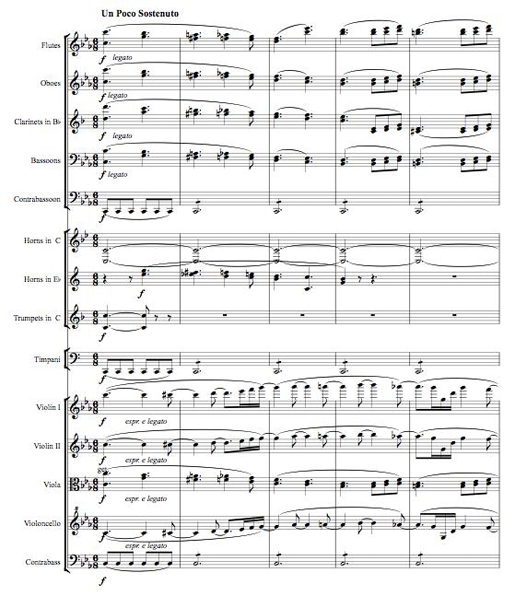
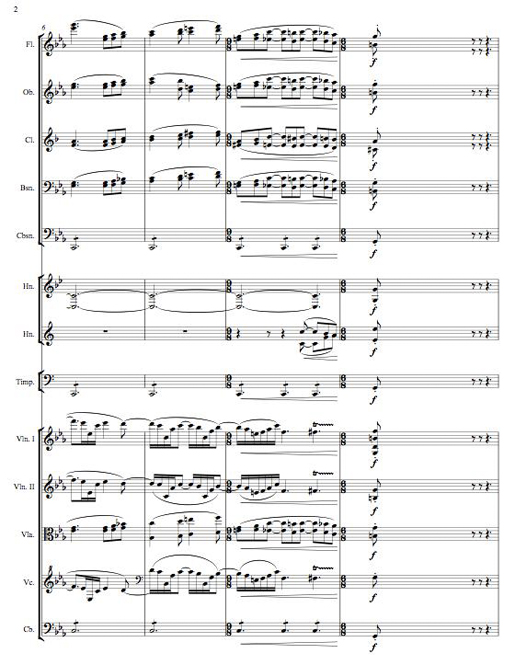
Many have remarked about Brahms's First Symphony and its debt to Beethoven—the most overt example of that debt being the similar character of the theme of Brahms' last movement and Beethoven's "Ode to Joy" theme in the finale of his Ninth Symphony. The opening of the Brahms above is a perfect example of one of those melodies that you cannot sing to a friend—it is pretty funny and frustrating to even try, and while Brahms also wrote many perfectly singable, gorgeous melodies, this opening does bear out George Bernard Shaw's quip, in this case at least, that you can't sing Brahms. This disavowal of singability, I believe, is a Beethovenian gesture.
It's easy to see how unsingable this opening is by trying to sing the violins or cellos, which double the melody in octaves. The upwards-chromatic climb of the line does not sound like much by itself. Then, starting at bar 5, the intervals grow and descend in wide leaps. Just to sing these intervals in tune requires pretty good pitch. This is not a melody that the layman walks out of the concert hall whistling or humming, like he does with a theme from a symphony of Tchaikovsky (who did not warm to Brahms's music at all, at least in his correspondence).
The other factor is rhythmic displacement. Already in the first bar, Brahms introduces a key motivic component by making the C-sharp in the melody anticipate the downbeat of the following bar by one eighth note, and he continues with this practice, anticipating the downbeats at the beginning or halfway point of each bar. We shouldn't underestimate the audacity of opening a symphony like this—if the symphony was hard enough to sing without a piano standing by, the anticipated upbeats ensure that your poor friend will be completely rhythmically lost as soon as you start singing it to him or her, unless you're ready to bang out some eighth-note triplets. If Brahms was a less original composer, he might have written the opening without this rhythmic anticipation. Brahms was nothing if not a supremely imaginative rhythmicist. Here is how a more rhythmically "square" composer might have approached the opening:
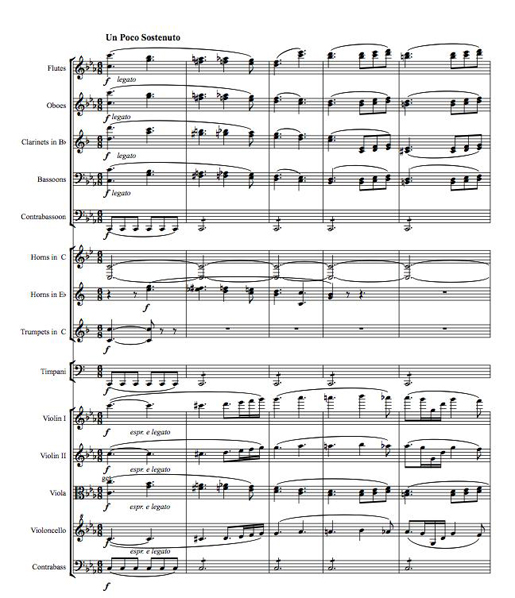
The violins and cello now play on downbeats. It's perfectly acceptable, but nowhere near as unsettling. The rhythmic displacement, along with the chromaticism and wide leaps of melody, is what makes the symphony unlike anything else. Everything works together: The rhythmic anticipation is easily felt and heard as a wonderful syncopation once we have the timpani, basses, and contrabassoon pounding out those killer low C eighth-note pedal points. Likewise, the melody needs the rich harmony of the woodwinds, horns, and violas that descend in the opposite direction to tell its chromatic story—and in this sense, then, the story is a harmonic story as much as it is a melodic story. That is big, and it's why Brahms is so big: he was able to fundamentally shift the focus of musical narrative away from a singable melody. This, more than the cosmetic similarities between Brahms' First and Beethoven's Ninth, was how Brahms honored the symphonic legacy of his great predecessor.
The harmony itself is a kind of protagonist in Brahms's symphony, and this is an undoubtedly modern gesture. Although the harmony of the opening is completely stamped with Brahms' identity, he is not reinventing the wheel here—it owes much to Bach. (Play the opening of the symphony back to back with Bach's Toccata and Fugue in D Minor, for example.) Rather, Brahms' innovation is in the way he reassigns the role of a musical component like harmony in the unfolding symphonic narrative. This opening is undoubtedly about something, but it's not something that you could pluck out and sing to a friend. Its identity is spread throughout the whole texture, and each part is interdependent. It is the malleability of identity that is deeply modern. To forsake melodic primacy is to forsake a definition of beauty that rests on clarity and comprehensibility. When the melody is not easily identifiable, what draws us in?
This rhetorical question is the subject of the symphony: As with Beethoven's Ninth, the story begins with non-comprehending angst and moves towards the clarity of melodic primacy in the last movement. Both symphonies arrive at famously singable melodies in their last movements, implying a victory of melody over motif finally—a counter-disavowal of the more motivic form of expression that the symphonies began with. Beethoven and Brahms say to us, "Here is melody, it does indeed have primacy," but it is really the motif that reigns supreme. What draws us in and holds us there for the duration with Beethoven and Brahms is the omnipresent motif.
For Brahms and Beethoven the symphonists, melody is a creation born of the motif—it is not the simple "gift" we talked about earlier: It must be earned. The motif is the source, the raw stuff from which melody springs. The melody acts like a mortal being, is always immediately perceivable yet intermittent—it comes and goes. It is always in flux, transient, and temporary. The motif acts like that mortal being's omnipotent creator: It is not always immediately perceivable yet always present—it is constant and fixed; it is forever. The melody is beautiful; the motif is sublime. If the melodic activity throughout a large-scale work has motivic continuity, then it makes a claim at sublimity as well.
It's easy to stumble on the term "motif" because it is vague: Often, the melody and motif are one and the same thing in a discussion about a work, but usually, the motif is an isolated part of the melody that has specific intervallic and rhythmic properties. It may sound melodic in itself; it may not. Here are the opening bars of Beethoven's Ninth:
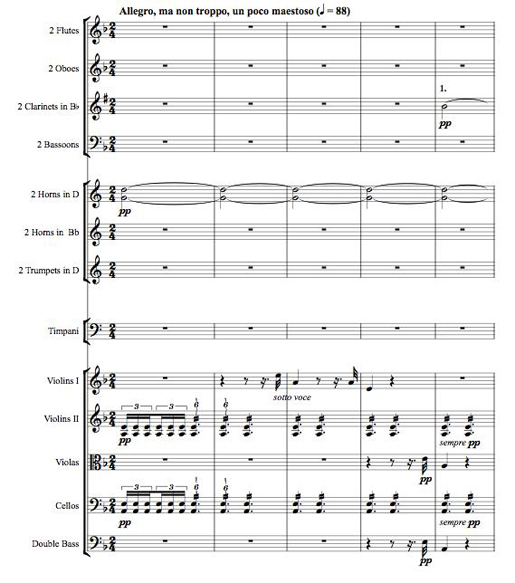
The motif has two quickly recognizable features: the interval of an open fifth, and the highly dotted rhythm that we hear first in the first violins, answered in the next bar by the violas and basses. As a melody, that figure is little more than a wisp. But that's the idea. When a proper melody begins and we hear the first real theme of the movement at the pick up to the seventeenth bar,

we then see that the motif was preparing us for it-the melody employs the motif's dotted rhythm, and the interval of the fifth is inverted.
For the first 16 bars of the symphony, Beethoven uses only two notes—an A and an E. Our ear, the first time we hear this, assumes that we are hearing a tonic fifth, with the A as the root. We sense that we are in some sort of "A" tonality. Whether it's A major or A minor is not clear because there is no minor third or major third interval above the A that would indicate the mode. So we feel a sense of suspension, but whereas suspension in classical music from Bach on had implied an incipient resolution, here we are suspended in mid-air as it were, with no sign of where we might be headed. In those opening 16 bars, Beethoven has succinctly sketched a musical portrayal of chaos and formlessness.
For me, the effect of this opening never diminishes. Even though I know the symphony and know what's coming, I am never prepared for the D-minor tonality that is coming down the pike, until it gets there and blasts itself into my body and brain. When the main theme does enter at bar 17, it creates a unique, unsettling feeling that was new to music: Instead of lessening the vertigo of the beginning, it increases it. It is as if we have been standing on a precipice in the clouds, not sure of what is underneath us. Then some of the clouds clear, we can see the ground from our high precipice, and all of the sudden we realize how far away we are from the ground.
But why are we still in the clouds, filled with only more vertigo? Why doesn't the firm tonality of D-minor in the theme at bar 17 ground us? Hasn't this whole beginning just been a long and drawn-out V-I progression? Not really: The open fifth of A and E, in itself, does not qualify as a functioning dominant: It lacks a C-sharp leading tone that would pull us towards the D tonic, or a G that would pull us towards the F natural of the D-minor triad. It is stubbornly directionless. It is a motif, which means it is an empty vessel for now, waiting to be filled. So when the D-minor theme arrives, it does not feel like it resolves what preceded it—on the contrary, it feels like a usurping.
Beethoven creates that feeling of space between the dominant and tonic through the vagueness of the motivic open fifth. But how exactly does he draw those clouds away from underneath our precipice? The secret is the bassoons and the horns in B-flat. Let's look at the full score from bar thirteen, as we head into that terrifying theme:
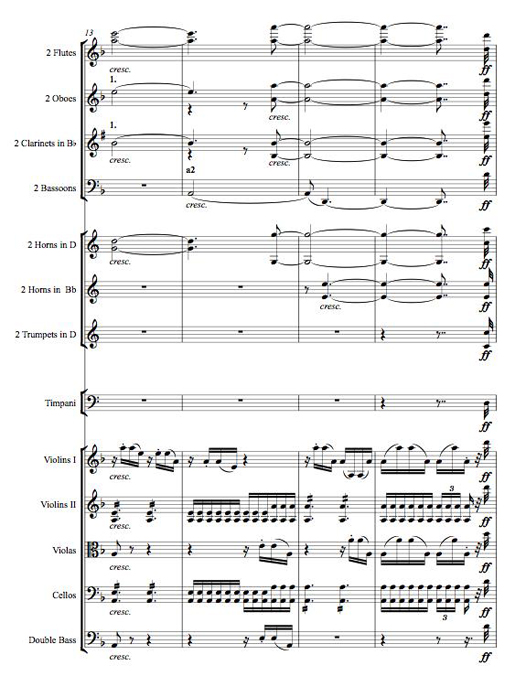

At bar 15, the bassoons and B-flat horns play Ds. They do not start on the downbeat, but come in on the second eighth note of the bar. This is a masterstroke—they sneak in upon us rather than landing squarely, and in this way the effect is more of a subtle shift and less of an overt transition—an A pedal point is shifting to a D. After all, this is not any kind of harmonic resolution at all—it's more like a drop. In a symphonic texture, everything always blurs together a bit, and Beethoven exploits this blur. We still have the motivic A-E open fifth in our ears, and then the Ds of the horns and bassoons nestle under the A. For a strange, blurred moment at bar 15, our ears perceive something like this:
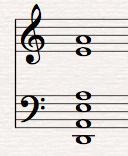
Beethoven is like a storyteller who says to you: "I am going to tell you about a beautiful princess and a prince and a dragon." And so you roll your eyes because you're sure you've heard it before. And then he starts to tell you his tale. All the characters are there, and all of the themes are there-love, nobility, good conquering over evil, bravery—but some things have been switched around: The dragon, perhaps, is the one who falls in love with the princess. And the princess is torn between the dragon and the prince. Maybe the dragon isn't purely evil; maybe the prince isn't purely good ... Maybe the dragon is the prince. Beethoven uses the same material as everyone else and then pokes a hole in it, so that something new springs forth and we see everything in a different way
Part Four: Jazz's High Stakes and Tragic Failures
There is a heroic aspect to a musician who continues to create; creation becomes an act of conquering. But what is he conquering? He is essentially conquering himself, over and over again, conquering his own urge to accept the status quo of his present form of expression. However exalted that means of expression might be compared to another musicians'—it may tower over all of his peers' and most of his predecessors'—it is status quo for him because he has mastered it, and once mastered, that means of expression becomes steadily less compelling to him. To accept the status quo then is tantamount to defeat; it is to lie down and die.
Two urges wage a struggle against each other: the difficult, life-affirming urge to create oneself all over again, and the easy, deathlike urge to give into one's own success. There is a lot of potential drama and pathos in that kind of story, and if we try to apply the three-period model we touched on earlier to musicians and composers at large, there will be mostly unhappy endings because the majority of musicians simply do not manage to perpetuate their initial level of creativity as the years go on.
That has an interesting set of consequences for jazz, which places a premium on improvisation. Improvisation, in the narrative of jazz, is essentially a trope for creativity. When we witness an inspired improvisation, we are witnessing the creative act in real time, in a raw, unbridled form. This is what distinguishes jazz music from the completely written canon of Occidental music that is one of its points of departure. Jazz music at its best has an exalted status among all forms of musical expression because of the way it simultaneously adds to this Western musical canon and transcends it.
It is true that many forms of music around the world are largely improvised; jazz is certainly not unique in that sense. But the profundity of improvisation in jazz is unique, and that profundity arises partially because of jazz's deep engagement in a tradition that is more Bach than blues: The tradition of 12-tone functional harmony. (I don't refer to Schoenberg's 12-tone system! I mean to say: The harmony that comes about from the twelve chromatic, tempered tones that are produced on pitched instruments. I make this distinction because the blues scale, from which jazz and other music draws so much material, was not derived from these 12 pitches of modern temperament. With its diminished key intervals, it shares characteristics with folk scales from other parts of the world.) The principles of voice leading, the perpetual rub of consonance and dissonance-these principles are accounted for in a Lester Young solo as well as the blues. The blues is subsumed within a greater understanding of functional harmony and all of its consequences. This is not to mention the formal complexity of so much jazz, which eclipses that found in folk musical expression. Complexity in itself is nothing, but when that complexity is tied to inspiration, there is the possibility of a deeper level of profundity. Something great can take place. You have the potential for music with those grand-narrative gestures that Beethoven was aiming for, expressed as spontaneous, here-and-now utterances.
This is the greatness of jazz, and to deny the role of a specifically Occidental source in its formation—among other sources—is merely to marginalize jazz. With elements of folk music and classical music, jazz can transcend both: At its best, it will achieve the discursive complexity of classical music while retaining the ritualistic intensity of improvisation. The political implications of this claim to jazz's transcendence are interesting. The claim implies elitism—the implication is that the experience of jazz will be qualitatively better than other types of music—yet there is more recently a prevalent view of jazz that is more internationalist and populist in its tone. In this viewpoint, the thinking goes, all types of music—not just the original African-based folk elements of American jazz at its inception—are welcome under the big tent of jazz, and that viewpoint manifests itself in the programming we see at jazz festivals, where a DJ will spin a set on one stage while a klezmer group performs on another. To one observer, this is a fresh change; to another, it is a crisis of identity. Yet this unresolved discourse on the identity of jazz is tangential to the issue of its creative success: That success rests on inspired improvisation that is nevertheless grounded in nuanced understanding of functional harmony; there can be no sidestepping that. And any such inspired improvisation will always be essentially elitist in its nature, because it will eclipse everything else going on in the big tent. (Every major jazz innovator—including Ornette Coleman, in his own completely original way—has engaged deeply in the fundamentals of 12-tone harmony.)
But what an enterprise-it sounds almost impossible to achieve a deeply informed musical statement in the white heat of the moment. The stakes are high: When we witness an uninspired improvisation, we are likewise witnessing raw evidence of creative failure in real time. It is a failure that is perhaps more lucidly felt than hearing the interesting written failure of a composer. When a jazz musician is ostensibly improvising, but actually playing something worked out that he already knows, a potentially tragic component now exists in his personal narrative of creativity: he has failed the specific challenge that jazz poses. Yet this tragedy of creative finitude is one that the great majority of jazz musicians will eventually encounter; we could even say that it is the normal occurrence in jazz. As such, it is not witnessed directly as a failure. It is merely the meek rendering of human limitation, of the ineluctable fact that most of us cannot live in a constant state of inspiration. Because the limits of creativity are so prevalently felt in jazz music, and can be witnessed even among its best practitioners, we must find another account for this drying up of fresh inspiration. Another way to view this phenomenon is that it is evidence of a musician's humanity—and, to the extent that his narrative corresponds with ours, we who listen—evidence of our own humanity.
Input and Output
In Rainer Maria Rilke's Briefe an einen jungen Dichter, he writes, advising the young poet:
Alles ist austragen und dann gebären. Jeden Eindruck und jeden Keim eines Gefühls ganz in sich, im Dunkel, im Unsagbaren, Unbewußten, dem eigenen Verstande Unerreichbaren sich vollenden lassen und mit tiefer Demut und Geduld die Stunde der Niederkunft einer neuen Klarheit abwarten: das allein heißt künstlerisch leben: im Verstehen wie im Schaffen.Rilke is explaining how a person assimilates the material that he uses to create his own art. This process is one that is not overt and palpable—it takes place "in the dark, in the unsayable"—so we need a metaphor that accounts for its mysterious nature. Rilke finds that metaphor in his austragen—the German verb that is formed from tragen, to carry, and means to carry a child in the womb to full term. The artist is the pregnant mother who carries the child in her womb, and the child that grows there is the unformed work that he will create. When a woman is pregnant, she is growing something inside of her, but the nature of what she is making remains a mystery until the birth. When the child is born, it is a beautiful surprise. When a jazz musician finds his or her own style, the style joyfully announces its own "birth" in a similar manner.
(Everything is gestation and then birth. To let every impression and every germ of a feeling complete itself, wholly in itself, in the dark, the unsayable, the unconscious, unreachable by one's own conscious understanding; and then to wait with deep humility and patience for the hour of deliverance, when a new clarity comes: This alone is the artist's life: in comprehension as well as in creation.)
It is possible to illuminate this mysterious gestation period a bit more by employing another metaphor that I take from a conversation with the musician, composer, and producer Jon Brion. Working in recording studios for years, plugging in microphones to pre-amplifiers, running signals to mixing boards, etc.; he was always distinguishing between input, the place where information enters a device; and the output, where the information leaves that device. The terms input and output also refer to the information itself on a device like a computer hard drive, and specify which direction it is moving—whether it is coming onto the hard drive as input or leaving as output. The creative musician is a vessel of information as well. The input is all the music he or she listens to, and, more generally, everything he or she takes in—literature and other disciplines, but also emotional experiences and even sensory stimuli. The output is what one will then produce after one takes all of that in.
The first period of a jazz musician's development is full of input. There is listening, listening, and more listening. The young musician might transcribe solos, learn standards, or study a particular set of exercises or system of scales. He or she might study the way a great singer or instrumentalist interprets a standard. Exposure to others is key at this point—old dead masters, living peers, what have you. As the young player immerses himself in a variety of output from other players, he finds that he responds favorably to some music and negatively to other music. In this way, he develops his own sense of taste, and that taste, which will become increasingly more sharply defined as he grows older, will determine his own style.
This process of collecting and discarding can take place throughout a musician's lifetime but is more important in the earlier period because when a musician is exposed to something for the first time, the shock of discovery is more profoundly felt than it is with subsequent discoveries of music in the same genre. The strength of the positive emotional impression will increase the chances that a musician does not discard what he is exposed to, or to put it more simply: He will retain only the music that he loves unconditionally. The first step in developing your own style as a jazz musician is to fall in love with an existing style, to be an absolute fan, with all of the fan-aticism that word implies: to embrace that style fully and unquestioningly, with no constraint, with no reservations. Criticism of that style will come later if it must. But in this first period, the critical faculty is less important and potentially damaging. The young player must initially view his master with no irony; there must be no distance between him and what inspires him.
In The Anxiety of Influence, referring to a great poet who is absorbing the influence of a predecessor, Harold Bloom writes, "The strong misreading comes first; there must be a profound act of reading that is a kind of falling in love with a literary work." Bloom's singular insight was that great poets ironically misread their predecessors, as their predecessors did before them, and as any strong poet will do with their work after they are gone. By "misreading," Bloom does not mean that they make a mistake. On the contrary, this misreading is a precondition to creativity. He summarizes: "Poetic Influence—when it involves two strong, authentic poets—always proceeds by a misreading of the prior poet, an act of creative correction that is actually and necessarily a misinterpretation."
Bloom's thesis is a great aid when considering the duality of influence and originality in any creative pursuit. This duality is felt strongly in jazz. On the one hand, jazz is seen as a music that thrives on the spirit of originality, manifested in the act of improvisation: I can improvise whatever I want whenever I want; there is no rulebook. On the other hand, the drama of jazz, particularly in recent years, is found in its narrative of fathers and sons, mothers and daughters: Authenticity is cherished, and authenticity is directly determined by how well a player has absorbed the "lessons" of his or her predecessors.
Authenticity and originality are both weak tropes because, on their own, they can only account for weak players. True originality, and thus true creativity, never takes place in a historical vacuum; it is always rooted to something that has gone before. I remember observing the phenomenon of rootless "creativity" in my high school jazz band growing up. There were those of us who were listening to jazz and would go on to try to be musicians. Our fledgling attempts at soloing reflected whatever we had absorbed at that point—a little Bird, McCoy Tyner, Michael Brecker, what have you. Then there were kids in the band who were not going to pursue jazz for their life, had only a passing interest in playing music, and had hardly listened to jazz at all. They would also get a solo feature now and then.
What did they play? It was sort of like playing scales up and down the horn. What was striking was that they all sounded the same: One would think that with all the freedom that an improvised context could have, they might all play something different. But collectively, the kids who weren't really listening to jazz actually encompassed a style of sorts, and that style was dictated by their limitation. The limitation was due to the fact that they hadn't absorbed anything; they hadn't begun to even mimic like we were. There is a rule here, to gloss on Tolstoy: Rootless players are all alike, but every rooted player is rooted in his or her own way. Yes, there are tons of rooted players who are not original, but as a listener, give me the unoriginal player who has listened to a lot of great music and absorbed it any day to the player who hasn't absorbed much of anything. This brings us back to the importance of input again: Without input, we have no model for our own style; without learning a language, we have no model to create our own. There is indeed an international style of rootless jazz playing. In the name of creativity, it expresses banality. In its lazy quest for the original, it finds only unoriginality.
The champions of authenticity can take some poetic justice from that phenomenon. All their hard work, all their striving to do justice and pay homage to their forefathers, places them above the lazy, rootless denizens who never engage deeply in the music, who treat jazz like a subsidized vacation and not as a serious discipline. Through their loyal devotion to their influences, the authenticity-seekers have mastered a language; the rootless players merely babble with each other like babies on the bandstand. To be sure, there is justice for someone who devotes himself to the past in jazz: He has the comfort of his craft and the reassurance of deep knowledge. Still, knowledge alone makes him only a craftsman and not a creator.
Part Five: Bird's Wide Wingspan
 Literary critic Harold Bloom's idea of misreading celebrates originality yet gives a strong account of influence. It can be used to mediate between the competing tropes of rootedness and originality in the discourse on jazz, but only when considering a truly creative musician, as a truly creative musician is one who is simultaneously rooted in the past and expressing something new. Let's consider John Coltrane as one such musician and apply the same three-period schema to him that we explored with Beethoven. His recorded output in the 1950s constitutes a roughly drawn first period. Two strong predecessors of his are Charlie Parker and Dexter Gordon, and Coltrane's early style is a strong misreading of them both.
Literary critic Harold Bloom's idea of misreading celebrates originality yet gives a strong account of influence. It can be used to mediate between the competing tropes of rootedness and originality in the discourse on jazz, but only when considering a truly creative musician, as a truly creative musician is one who is simultaneously rooted in the past and expressing something new. Let's consider John Coltrane as one such musician and apply the same three-period schema to him that we explored with Beethoven. His recorded output in the 1950s constitutes a roughly drawn first period. Two strong predecessors of his are Charlie Parker and Dexter Gordon, and Coltrane's early style is a strong misreading of them both. Dexter Gordon's huge tone informs Coltrane's tone. They both seem to always be blowing with all their might; there is a sentiment of abundance and generousness. But the musical choices Coltrane makes do not correspond to Gordon's. Gordon favored singable phrases that were disarming in their simplicity and were rhythmically formatted smoothly and clearly to the chords he was blowing over. Here are the first 16 bars of his solo on "The End of a Love Affair":
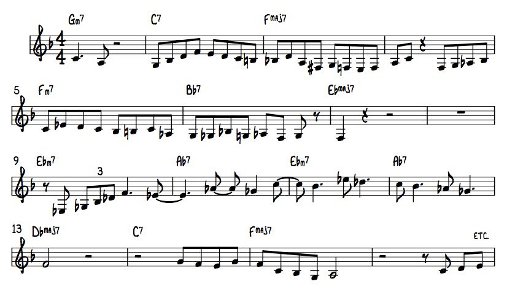
Dexter is a great place to start for beginning tenor players in the same way that Oscar Peterson is for piano players, because his lines are so clear. In the above example, we see quickly how he honed in on some of Charlie Parker's bebop shapes. A large number of tenor players of his time, like Gene Ammons or Stanley Turrentine, share a quality of his: Bird's phrases, rhythmically speaking, are often more square in Dexter's reading then they would be in Bird's own hands. They have a literal quality when we here them—they are telling us, "Here is how you connect the dots between this chord and the next chord." This is not necessarily a criticism: players like Dexter or Gene Ammons used the tenor saxophone to propel the whole band with the rhythmic force of their phrases, particularly at a medium tempo, and the simplicity of the phrase had something to do with the force.
Still, looking at Dexter's solo and then listening to Bird on any number of tunes with a similar chordal progression will highlight the revolutionary aspect of Bird's style: Bird's time is dead-on perfect, yet his phrasing is completely unfettered. His phrases start and end all over the place at different parts of the bar, and there is a far greater amount of rhythmic variety in his solos than is to be found in all of his predecessors. This is fitting. It is always the case that the inventor of a new means of expression has a seemingly unlimited reservoir of ideas; his followers, on the other hand, invariably take a piece of what he did and simplify it. With Bird, it is particularly easy to demonstrate this maxim by looking at hard bop and everything that followed in his wake, right up until today.
Dexter's phrases in the above example often start and end on eighth-note downbeats, like at bars 7, 13, and 15. As I'll try to demonstrate later, this is actually unusual in modern jazz improvisation: Phrases tend to end on the up-beats. The repetitiveness of the descending II-V-I progressions in this tune throws the square quality of his phrasing style into relief. We could, if we wanted, take these phrases and shift their placement within the progressions like pre-made squares of lawn without any trouble at all. It wouldn't change the essential character of the solo if we did this, moving chunks forward or backward:

Okay, maybe that last low F is a little weird! But you see what I mean. As great as Dexter's solo is here—we wouldn't want to change it of course—its phraseology is often generic; it is largely assembled from pre-made melodic shapes. The irony of Bird's innovation is that, because of the clarity of his musical ideas, it was easy to snatch them and paste them, as licks, into a given chord schema. Playing Bird licks, verbatim, is one strong definition of jazz hell. Bird's lines have an appealing symmetry that is easy enough to assimilate and mimic. Until Coltrane came along, Bird himself was the leading transgressor from the normative path that he created.
It would take a player like Coltrane to break free from this rhythmically formatted aspect of soloing, and if we look at the chronology of his stylistic development, we see that Coltrane's first innovation was rhythmic—melodic and harmonic innovation came later. Here's some of Coltrane's solo on "If I Were a Bell," with the Miles Davis Quintet in 1956. We start from the two-bar break after Miles's solo; the top of the chorus is bar 3.
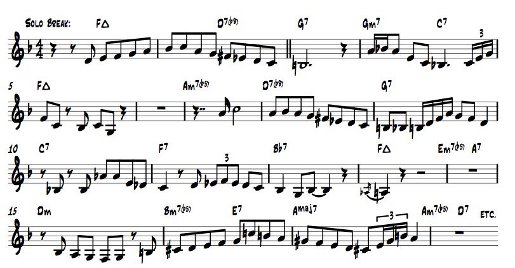
Because it's in the same key as the "End of a Love Affair" example and also abundant in II-V progressions, we can see clearly where Coltrane comes out of Dexter and Bird, and where he's starting to move away towards something rhythmically new and strange. In his solo break on the first two bars, the fluid stream of unbroken eighth notes could easily come from Dexter—not just the notes, but the rhythmic feel: slightly behind the beat, and more straight than dotted, wonderfully staggered. The phrase that follows, though, in bars 4 and 5, has more rhythmic variation and is broken up with rests. We see, importantly, triplets.
Bird's solos were full of triplets that were interspersed between regular 8th notes; this feature of his solos gave them rhythmic variety. I'll never forget a master class I attended years ago that the great jazz pianist and teacher Barry Harris was teaching. He was chiding all of us for playing endless chains of 8th notes. We may have absorbed some be-bop, but we weren't dealing with triplets for the most part. We could have a little comfort in the fact that we weren't alone—a lot of the great hard bop stylists from the 50's onward didn't really have triplets in their playing either. Having that in your playing, Harris maintained, was necessary for authentic bop expression—otherwise it was something else, something incomplete and weaker.
I never thought I was going to play be-bop like Barry Harris or another great Detroit pianist from the same generation, Tommy Flannagan, as much as I listened to them and absorbed their styles. But this idea that there was a true way of playing be-bop, and then there was this other way that did not make the grade—that made a great impression on me. To hear Barry Harris tell it, there were a bunch of players that I loved who did not make the grade.
To hear the alto saxophonist Lou Donaldson tell it—well, that was far more extreme! Lou would come down to a club where we younger musicians were playing and graciously listen to a set. And then when we'd hang out with him, he'd hold court. Boy, the things he would say! They often came in quotable sound bites:
"I got news for you—Coltrane killed jazz."
Just when we'd be reeling from this—almost kind of getting dark because it just seemed so gloomy, what he was saying—he'd crack us up with some other acid remarks. For instance, his take on a band that was playing that week at Sweet Basil's club, called The Leaders:
"The Leaders, huh? ... I'd sure hate to see the followers!"
His appraisal of Ornette Coleman and much of so-called free jazz was equally devastating:
"Free jazz—yeah, that's a good name for it. It should be for free! Nobody should pay to see that."
What I discerned, listening to Barry Harris and Lou Donaldson, was that a strong paradigm led to the most rigid aesthetic. Once you found out how great something was, everything else would just keep falling away—you couldn't use it anymore. It reminded me of Harold Bloom in his Shakespearean-scholar mode—even great writers like Melville, Joyce, and the like, for Bloom, were just riffing on Shakespeare, and none of them matched his power. The way these guys loved Bird—and Bud Powell, as we'll see in a minute—well, it didn't leave room for much else. It made sense: The more you find out how great somebody is, the more you realized how his followers don't match up to him. Still, it was troubling! Being young and hearing strong, unapologetic opinions from your elders is good tonic, though. After all, Barry Harris and Lou Donaldson were around when those giants were walking the earth. To them, Miles, Coltrane, and Ornette were just guys like them—they were their contemporaries, and not the towering giants they are for younger generations. So those guys could get away with saying the kind of stuff Lou said. Nobody else—not a critic, not a younger musician—could. We'd just sound like clowns.
I always thought—jeez, if Lou thinks that about all those great players, what must he think of my little turd offering I just made that last set he heard? My mind reeled. It's really, really good to be humbled like this, all the time. First as a young jazz musician, you should have that experience as you're forming your sound. It's like trimming off the fat from your style. It will make you less glib. It will make you less apt to spew and sputter and more apt to think before you express something. Then maybe you'll think too much and you'll get stuck in a rut of self-doubt … So be it—you go through that too, and get out on the other side with a stronger sense of your identity. Later, when you are at the height of your powers, at your full expressive reach, you should be knocked off your pedestal from time to time as well. Why? Not for the satisfaction of some boob who wants to tell you how and why you're nothing. No one else can tell you that at any stage in your life as a musician. Only you can make those judgments about yourself; otherwise they don't mean anything. If you're able to make a judgment about yourself honestly, though, you can force a change; you can grow. And often the way to growth is realizing how limited you are, how little you have scratched the surface of someone else's ouvre—someone like Bird, for instance. There are always opportunities, at every moment, for this kind of humbling cold shower.
The problem with teaching (and maybe the reason why I'm not convinced of my own ability to teach) is related to this. There is (not always but often) a frustrating Catch-22 with teaching: In order to be humbled—in order to be teachable—you have to comprehend the greatness of what towers over you, and if you really get that, doesn't that comprehension at least imply that you know what to do already? So a teacher should teach humility—but that sounds so … pious. How does one teach that humility without being a jerk—the kind of old-fart teacher that everyone moans about because he or she just tells everybody how inconsequential and meager his or her playing is? It's a fine line, and being able to walk that fine line is to me what good teaching is all about—nothing more, nothing less.
Part Six: Bud's Dance Between the Intuitive and the Counter-Intuitive
I went back to those players who didn't measure up for Barry Harris—those who didn't have the triplets in their playing—and examined them in a more critical light. They were mostly from the hard bop era that followed the bop revolution, roughly from the middle '50s to the early '60s. Now I noticed a paradox. One the one hand, I heard their limitations—I heard how their improvisatory vocabularies contained a piece of something Bird had done, but could never contain the whole of what he had expressed, and how that fact meant that there was a certain predictability in their playing. They didn't knock me out of my chair in quite the same way that Bird himself could at his best. On the other hand, I heard that their limitation was also part of the beauty of their expression: The way a player like Hank Mobley isolated key phrases from Bird and then placed them in the context of his own sound, his own compositions, and the bands he played with, was a beautiful tribute to Bird, but also built on Bird, forming a continuity. It was the way the music grew: incrementally; not always in great leaps and bounds. Not everybody could be Bird. It got me thinking along the lines of what I touched on earlier: that limitation in jazz has its own beauty, which has to do with the expression of humanity.
One great exception for Barry Harris was Bud Powell. Powell, perhaps more than anyone else in Parker's immediate realm, approached the rhythmic variety—and virtuosity—of Bird. Here is a snatch of Bud's right hand only from a solo on the Denzil Best blowing vehicle, "Move," in a band led by Bird. The tempo is stupid-fast—we need to split the time to get an existing metronome marking and come up with 168 half notes per minute. When I was coming up with other guys, trying to play these kinds of tempos, we simply called them "Bird tempos." Bird himself sounds incredible on them, Bud hangs in there valiantly, and most other players sound anywhere between limited and silly. This is the second A section and the bridge of a chorus of Bud's solo. Notice those triplets that Harris admonished us about—here they are in abundance:
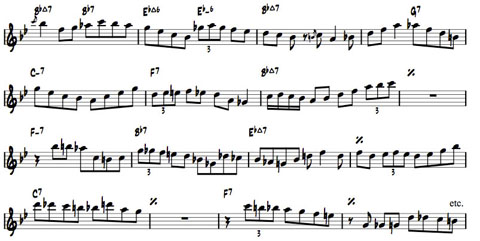
Ladies and gentleman—a master. Here is a stream of ideas worthy of Bird himself in terms of variety of phrasing, melodic and harmonic invention. That this solo is packed with so much substance is all the more astounding when you consider the ridiculously fast tempo of this performance. The way to get into solos like this is to bring them down at first to a medium groove and explore them up close. Then you see that there is no flimsy architecture—there is no meaningless playing that the fast tempo is hiding. Bud, like Bird, has a Bach-like quality: You can slow him down, you can speed him up, you can change the key, you can change the instrument—and it will sound good. This weatherproof quality of the music that Bud Powell and Charlie Parker made, this durability in any context, is truly humbling.
The key to Bud's deepness is that he's really just going for it at this tempo—he's hearing stuff in his head, and then he tries to play it. Take for instance the last two bars of the bridge above:

You could argue that Bud actually intended to play this:

Then the line flows naturally; there's no hiccup. Without the imagined E-flat that I've inserted on the downbeat of the second bar, the listener hears a very dissonant E natural ending a phrase on the last upbeat of the first bar that drops off to nowhere. With the E-flat, we have one smooth two-part phrase with continuity. The E-flat is the pivot point between the two bars. The reason, one suspects, that Bud didn't play an E-flat there, was because of the sheer difficulty his brain confronted in the white heat of his improvisation at this tempo: Pianists, try fingering that line with the added E-flat at any tempo and you see that it's awkward; then try at the tempo Bud played it—it's next to impossible. So, in that fleeting moment, Bud picked up his hand for a fraction of a second and shifted, so he could catch the low G with his thumb.
Trying to figure out how to finger what Bud actually did play in his up-tempo solos can keep you busy for a stretch, and you may not come up with anything. Bud's solo here is hard in a 20th-century classical music way, or maybe that's my personal bias: I remember transcribing this solo and then trying to play it at the same time I was working on Samuel Barber's Piano Sonata and Prokofiev's Seventh Sonata. Strangely, although Bud's solo is in such a different expressive world from those pieces, it poses some of the same fingering challenges for the right hand—it has the same kind of nasty, finger twisting, kind-of-chromatic-but-not-completely-chromatic lines that those pieces have, and can be realized in a performance only with a similarly counter-intuitive fingering approach. That is striking in the case of the Bud solo, because Bud did not write it out ahead of time. There's high speed trial-and-error decision making going on here, but it's behind a curtain: We only hear the end result in that musical phrase that flies past us. There's something going on here that is not normal, and it goes to the heart of what (great) jazz improvisation is all about.
Here are three types of jazz improvisers:
Intuitive
Pros: In the moment, in touch with the source of one's inspiration. The ideas flow easily, unrestricted. One is truly hearing something and then playing it, as is the ideal.
Cons: It's hit and miss. The ideas are not necessarily earth shattering, fresh, or particularly original. It's whatever one feels at a given moment, which can be arbitrary.
Counter-intuitive
Pros: Not repeating oneself too often, can sustain the listener's interest without actually being inspired. Sometimes comes up with something that has never been played before.
Cons: It's hit and miss. The ideas are not necessarily beautiful, flowing, or particularly iconic. It's whatever one avoids and backs away from, taking another path, at a given moment, which can be arbitrary.
Intuitive and Counter-intuitive from one moment to the next
Pros: In the moment, in touch with the source of one's inspiration. And if the source becomes obscured, if the light flickers a little, jump to a counter-intuitive approach; that way you will not repeat yourself too often, get bored, and become boring. Then remain open—and the inspiration will return.
Cons: None. The very process of switching between the head and the heart yields a multi-dimensional listening experience in itself. It ensures variety. It's what the great improvisers are doing—they're constantly hopscotching between the intuitive and counter-intuitive approach. And it is what Bud is doing on the micro-level here with his quick fingering adjustment: He has an intuitive line that he hears at that tempo—in fact it's a shape that comes from Bird, especially the second half of it—and then he realizes that at this tempo in this key, with this particular order of notes, it will not be possible to make it to the low G on the upbeat of 1 on the second bar. So he picks up his hand and severs the one idea into two, counter-intuitively.
Or—intuitively: In fact, we could say about Bud and other master improvisers, that it is ultimately all intuitive, that the counter-intuitive becomes intuitive. If you are truly improvising and playing what you hear in a given moment, it means that you will come up against shapes and patterns that are not necessarily lodged in your finger memory through repeated practice and playing. So you get used to a constant calibration and adjustment of what you already know, and a constant confrontation with something that is not yet known. Well, you should anyway. Again, the thought comes to mind: How do you teach that? How do you impart that process to someone else? Whatever the case, as someone who's probably had a few moments of inspired improvisation along the way—there's my two cents. You do that, like Bud did it. Good luck!
The way these decisions are being made in fractions of a second, in a kind of continuum, and all the while, Bud is engaged in the storytelling continuity of the big picture—the solo itself, as a whole—well, this goes in a list of the best things that people can do, in there with great athletic accomplishments, scientific breakthroughs and the like—it is not a normal skill; it is not a normal form of expression. It is where I locate the sublime in jazz.
The Primacy of the Upbeat in Swinging Jazz
What is the musical pay-off, though, for the listener? How is Bud's skipping over that E-flat an aesthetic victory as well, and not a failure? After all, we lose the symmetry and cohesiveness of the long phrase; we are left with a dangling dissonance; we are left with an awkward ending on an upbeat. The quick answer is: Jazz is not about symmetry; jazz is all about these kind of dissonances; and, more importantly, in matters of rhythm, jazz is all about ending on an upbeat.
Within the great, swinging feeling of so much of jazz, the roles of downbeats and upbeats are opposite those of several centuries of Western art music. Specifically, the musical phrases lead to an upbeat and end there. Here are a few examples of melodies, with arrows given on those upbeats.
Charlie Parker's "Ornithology":
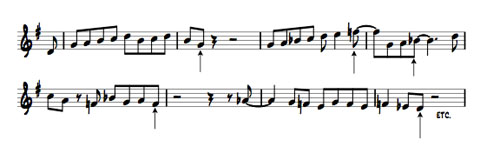
Billy Strayhorn's "U.M.M.G.":
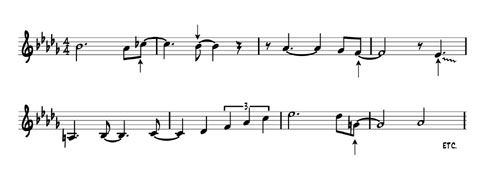
On Tadd Dameron's "On A Misty Night," we see how upbeats can be a release of rhythmic tension in jazz. The three half-notes that begin the piece are building tension here, which is then released on those arrowed upbeats. The rhythmic impulse is exactly opposite from classical phraseology:

Oliver Nelson's "Stolen Moments" is all about eighth-note upbeats—it's where all the action takes place during those famous chromatically ascending and descending chords built from fourth intervals:
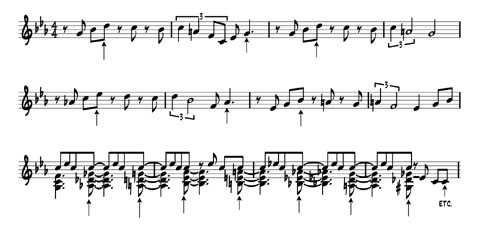
Even Coltrane's "Giant Steps," a harmonically based melody with little rhythmic variation, ends its famous chordal sequences on the anticipatory upbeat of 4, and not on the following downbeat:

Again, downbeats are tension leading to the release on the upbeat. This looks similar to the first two bars of Dameron's "On A Misty Night," which Coltrane played on as well—it might have rubbed off on him.
This rhythmic paradigm in swinging jazz affects everything—it in turn affects the melodic rhythm; it affects where consonance and dissonance take place within a line. The classical model of counterpoint begins with the premise that the upbeat is a stepping-stone on the way to consonance, which arrives on a downbeat. I do not refer to a final, resolving consonance; I refer to the provisional resolution from dissonance that is constantly taking place within a melodic line that has one or more additional voices above or below it denoting harmony. Take a relatively simple texture, like the first few bars of Bach's Prelude in F-sharp Minor from Book I of The Well-Tempered Clavier:
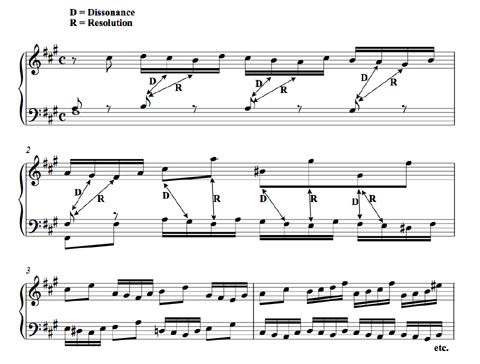
In the first two bars, I've marked the dissonant intervals that arise here from the simultaneous sounding of the left hand and right hand notes—they are major and minor seconds, a perfect fourth and an augmented fourth. All except one take place on a sixteenth-note upbeat, resolving immediately to a consonant interval on the following downbeat. The downbeat is the destination.
In jazz, though, the upbeat is the destination—and thus often a point of consonance. Again, "Ornithology":

So Bird might have played that Bach Prelude above like this,
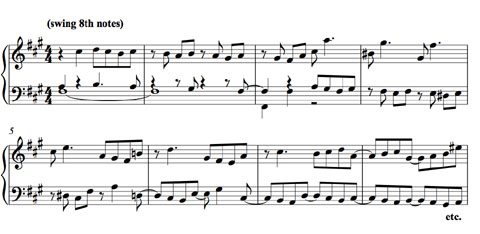
resolving phrases on upbeats, and Bach might have played "Ornithology" like this,

resolving on downbeats.
Okay, okay—I hear some of you out there protesting—jazz phrases that end on a downbeat are easy to find. I'm demonstrating a principal, though, not a rule.
In swinging jazz, phrases that end on downbeats are often a kind of square novelty, connoting humorous irony. We do not expect their squareness in the context they arrive in, and they grab our attention and make us smile, as in the melody of Thelonious Monk's "I Mean You":

The tail of the opening phrase has a square, oafish quality to it. Monk modulates it, developing it just a bit, and displaces it so everything is more properly jazz, on the upbeats. At bars 6 and 7, though, the square guy drives his point home once more, as if to say, "No, it's this!" The way in which Monk's motifs become droll, insistent characters reminds us of the similar humor we saw earlier in Beethoven's Diabelli Variations.
Likewise, phrases that accentuate the upbeat are of course all over classical music. But until the 20th century, they have an ironic function; they are not the norm for the context in which they arise. Theodor Adorno, in his disappointing misappraisal of jazz, wrote off its rhythmic singularity, sourly maintaining that Brahms had already written such syncopated music. I'm guessing that he meant something like this snaky passage from the scherzo movement of Brahms' second cello sonata:
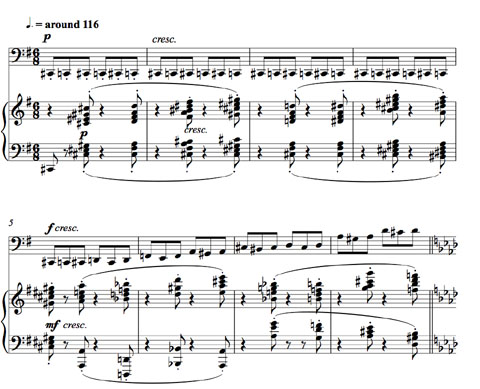
The rhythmic displacement of those piano chords is downright funky, and to show how rhythmically hip Brahms was, we could use our trick again of making the square version that a less inspired composer might have come up with, like we did earlier with the opening of his First Symphony. Then see that those spooky upbeat piano chords are a skewed, off-kilter version of this kind of normality:
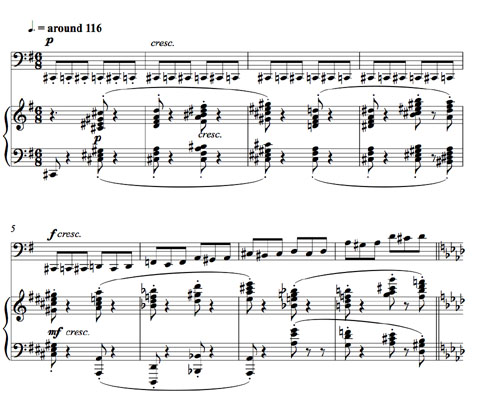
It's perfectly acceptable when we place those chords on downbeats—the tension still builds from the modulation and the insistent thematic economy. But what Brahms actually wrote really can make your butt bounce, and in the hands of some grooving musicians, it's possible to make that passage swing in a certain fashion. (Emmanuel Ax and Yo-Yo Ma achieve that in both of their recordings on RCA and Sony. The way Ax plays those offbeat chords is nasty and subtle—it's like he's sucking the notes out of the piano. That is some of my favorite piano playing right there, and incredible music making between those two guys.)
Nevertheless that passage is an effect for Brahms—it is designed to build tension; it takes place in a movement whose melodic phrases are largely ending on downbeats. The release of rhythmic tension— the provisional destination of all this restlessness—immediately follows, with phrases that end on downbeats. Let's look at the same passage again and extend a little further to arrive at that rhythmic resolution:
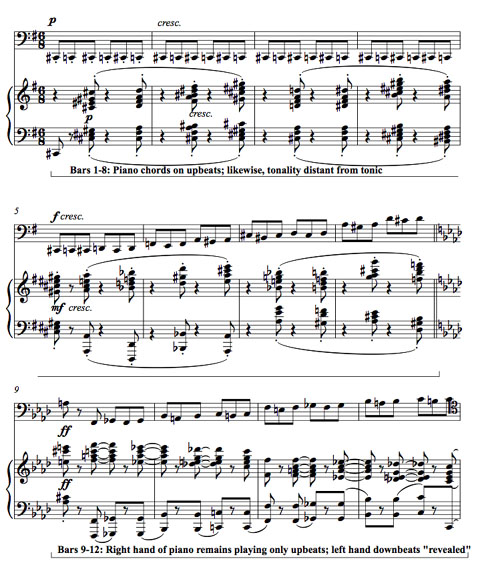
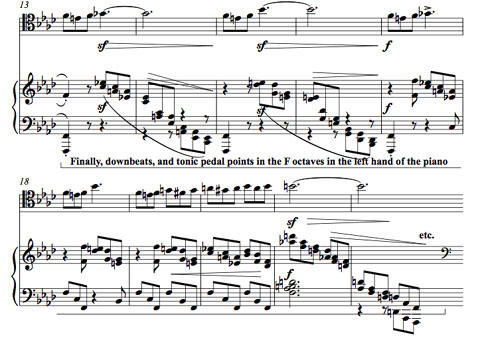
This is Brahms at his hair-raising, scary-funky best, masterfully building tension and then giving us provisional release. For the first eight bars that we've already seen, the piano plays only the weird upbeat chords. At bar 9, the right hand stays with that upbeat pattern, but the left hand octaves add downbeats immediately after. It is a wonderful effect when they appear because they act on us retrospectively: It is as if there were notes there all along, but they were written in invisible ink; now they are revealed to us. This reminds us that syncopation achieves its effect just as much from absence as it does from presence. It does not only emphasize the "weak beat"; it also withholds musical information on the downbeat, confounding our expectation.
Bars 9-12 segue toward rhythmic resolution at bar 13—the downbeats are emphasized with accents and sforzandos to drive the point home. Note that partial harmonic resolution is reached here as well: Bar 13, with its emphasis on the downbeat, also signals a large pedal point over the tonic home key of F. The poignancy of this moment is thus twofold: The otherness of those more distant shifting tonalities from bars 1-8 is vanquished in the same moment that the downbeat reasserts itself. The moment of nobility for Brahms, if you will, must land on "one," in both the harmonic and rhythmic sense.
Syncopation in classical music operates by confounding our expectations when it withholds the emphasis on the downbeat. Swinging jazz music that emphasizes upbeats, though, is surely not one long act of withholding—the rhythmic pleasure of swing has a deeply satiating effect on the body. The reasons why swing feels good, quite simply, are different than the reasons that that passage of Brahms feels good. To speak about syncopation, as commentators long have done when describing jazz, is even misleading in as far as syncopation is a trope for rhythmic otherness. The accented upbeats so prevalent in jazz are not the Other—they are home base; they are part of jazz's DNA. In a swinging 4/4 meter, we clap on beats two and four of the bar:
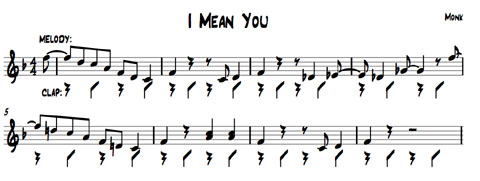
The upbeat has a primacy in a swing feel. There's no "rule"—clap wherever you like—but for someone who has the feeling of swing in his or her body, it feels wrong to clap to that kind of swing-based music on beats one and three, as one might to a 4/4 meter in much of classical music. I suspect that the way the upbeat prevails in swing in this larger metrical sense correlates with its primacy within a melodic line that we looked at in the examples above. This rhythmic unity of the universal and particular in jazz is what Adorno seems to have missed; he heavy-handedly applied a rhythmic paradigm from the Western art music in his field of knowledge. In doing so, he strikes me as unwittingly engaging in the kind of dominating thought and bad universalism that he is so critical of elsewhere in his own writing.
So, going back to Bud finally—when he plays that truncated phrase we looked at above, that ends on the eighth-note upbeat at the end of the bar, it sounds hip; it sounds natural. Should we wonk out and speculate why it feels good? It's only speculation, but here's my two cents: It's all about the swing feel, and the swing is all about triplets. Those triplets could never be notated accurately to reflect one way of swinging; this is why common musical notation hits a dead end with jazz in terms of rhythm. When we commonly write eighth-notes in a swinging jazz setting, we rely on the individual player's feeling for swing, and in an ensemble, we rely on a group consensus as to how those eighth-notes will be stated among the players.
Put briefly, the result of that consensus among the players in the rhythm section of a group—the drummer, bassist, pianist, and often guitarist—is the expression of a group's feel, and the particular feel of a swinging rhythm section is one of the ways it asserts its individual greatness, as in the rhythm sections of the John Coltrane Quartet of the '60s, or the Miles Davis Quintet of the '50s and '60s. We speak of performative gestures here—we cannot accurately write down drummer Elvin Jones's triplets or drummer Jimmy Cobb's triplets. Yet the feeling of these drummers—and the other musicians who interact with them—is as much an integral part of the identity of those groups as what can be notated—the solos, the chords of the piano, the bass lines.
There is a notational poverty in jazz where rhythm is concerned, an inability to forensically portray on paper what was great about those most dynamic rhythmicists in jazz, the ones who have changed the music and who are part of its unshaking identity today in everything that we play. This is why jazz's canon for many is a canon of recordings—it is a performative canon more than a written canon. I do not wish to mystify or reduce the written achievements in jazz, and likewise those who have made the worthy effort to strengthen our sense of a notated canon in jazz. There is the opportunity, though, to deconstruct a binary that I've focused on and tried to make a theme in my residency at Carnegie Hall this season: written vs. unwritten. The jazz legacy clearly inhabits both disciplines.
I think that that duality in jazz can lead to some interesting questions, in turn, about classical music. Do we perhaps give classical music an aura of (privileged) authority in the larger culture because its canon is more notatable? Is that good for classical music in general—could the classical music culture perhaps benefit from a shift in perspective, and take the focus a bit off the written canon, placing it more on performance? Instead of learning the 32 Beethoven Sonatas, what would the classical music scene look like in some alternate reality if pianists focused more on learning Beethoven's gestural language, his formal development, his way of organizing tonality, and then started trying to simply play something— partially or wholly improvised—informed by that? Classical musicians and jazz musicians, when they hang out, often have a conversation that goes something like this:
Classical musician: "I watch you jazz musicians and am jealous—I wish I could just improvise like that. But every time I try, I just have no idea where to start. I get nervous in part because I never do it."
Jazz musician: "I watch you classical musicians and I get jealous—I wish that I could play with that kind of precision and exactitude, and be able to play all that great repertoire. There would never be enough time to do that—I'd have to go back to school and start all over."
There are merits to both disciplines—but why can't we mix them up? The short answer, I think, is that we are, bit by bit, more and more. When I came to New York City in 1988, the two worlds were much more polarized than they are now. Now I meet classically trained musicians who are eager to engage in music that is not fully notated and calls for improvisation. I also notice that jazz musicians are becoming more and more curious about the classical canon, and, by feeding that curiosity, are becoming stronger improvisers and composers. One example: Younger jazz musicians today are on the whole simply better sight-readers than they were twenty years ago—good sight-reading is no longer an attribute of professional orchestras only.
Going back to the triplets, finally, with no more diversions! Here is a snatch of Charlie Parker's "Ornithology" once again, written the way it is normally notated, with those arrows that show how the upbeats are accented in the jazz feel:

If we had to try to reflect the feeling of swing, though, we might write something like this. Notice how those accents fall now—always on the third eighth note triplet of each group:

If someone played that literally, he or she would be in the ballpark—a kind of self-conscious facsimile of the ballpark—of swing. But what a mess on the page, with that cluttered triplet notation—why not simply change the meter to 12/8? Then we get this:
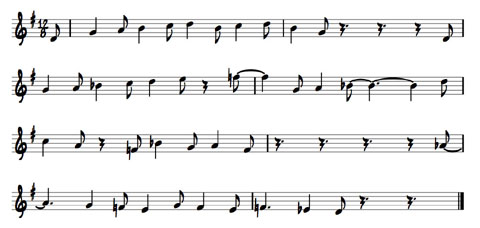
Okay, that works to point. But, to the extent that meter is supposed to denote the feeling and intent of the composer—did Charlie Parker the composer intend the band to be internally subdividing each bar 12 times? The triplets in a swing feel are implied in the melodic line, but they are not overtly stated in the rhythm section. The rhythm section reinforces them lightly in its upbeats, but does not subdivide these triplets so literally and so often. This is why those triplets were important to Barry in that master class, interspersed with eighth-notes: The eighth-notes denote the soft, bouncing feeling of the triplet already, and interspersing them with actual triplets gives outright expression to the subdivision of three.
Swing has its roots in dance, like other musical genres that are based in a feeling of three, but it is not a gigue. It is not even a hip scherzo like the Brahms we focused on above: In the Brahms—which I conjectured Adorno thought was jazzy because it accented the upbeats—the subdivided eighth-notes in the 6/8 meter are always literally felt—they are played in a continuous stream by the cello. There is no doubt about the primacy of "three" as a factor. In swinging jazz, though, that "three" is undermined by a larger "four" that moves across it and intersects with it—most obviously, the "four" of a bass line that walks quarter notes. We feel two things at once in swing, rubbing against each other wonderfully: the soft bounce of quicker triplet upbeats and the larger sturdiness of a slower meter in four. This mixture of slow and fast subdivisions has a twofold aspect, and accounts for some of the character of swing, which we trace around in the descriptive language to describe when it is strong: player X has a "fat" groove; player Y has a "big" or "wide" beat. Metaphors that denote largeness abound.
There is a ton of room in that larger "four"/smaller "three"—namely, room for all of that stuff that cannot be precisely notated. There is justice in that non-notatable quality. It is a kind of metaphysical insurance against flattening reductionism in an age where cultural artifacts are transmitted increasingly in a digital format.
MIDI—the prevailing digital means of rendering and manipulating musical information—will be with us for some time to come, but it does not account for the nuance of rhythm we find in swing. Every great drummer in jazz has a unique way of subdividing the beat into something we approximate as triplets when we have to give it a name. Billy Higgins, Philly Joe Jones, Art Taylor, Kenny Clarke, Elvin Jones, Tony Williams—and not to mention the great ones who are still with us, like Jimmy Cobb: Each one of these drummers has a particular, identifiable swing feel, and each gives us a specific feeling in the body that is now a part of the world's musical culture. The way we identify that in our body-memory has to do with a human form of interaction that is not reducible to an algorithm.
Part Seven: Final Detour: Bird’s Hegelian Blues
Finally, let’s look at Bird himself. Always at his most inspired, this solo on his own blues, “Cheryl,” comes from a live recording. Here it is in its entirety. In five brief choruses that last a total of just over one minute, this solo is a marvel in its brevity—he manages to say more here than most musicians say in a whole lifetime. The melody, or “head,” of the tune is given directly below, in concert key, followed by the solo:
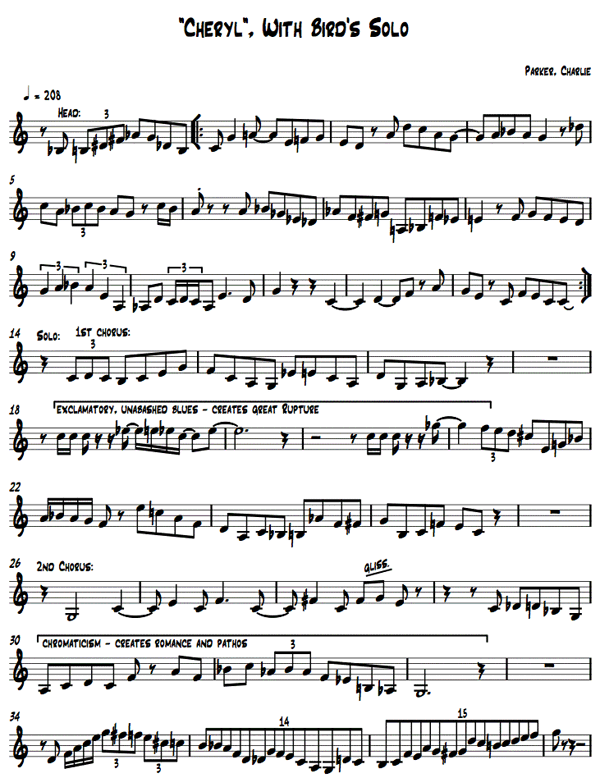
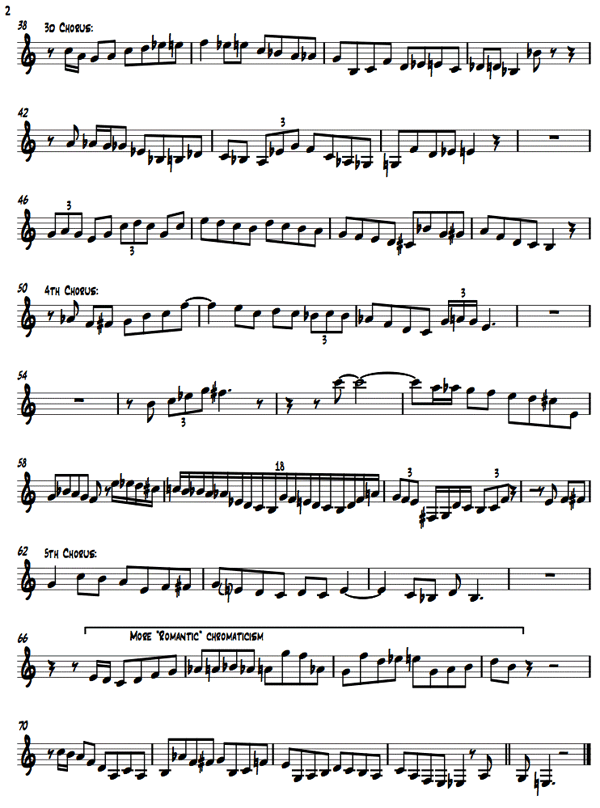
The thing that we notice about Bird’s solo, compared with any number of his imitators, is its ease and its wide reach. There is a strong, unmistakable identity to it; everything correlates to everything. Yet there is nothing dogmatic or fixed about the way that identity lets itself be known. So what you get is a variance of approach from one idea to the next that not one of Bird’s progeny could match. He is constantly switching gears and thus always keeping it fresh for the listener.
Bird likes to create disruption within a solo—something that many of his imitators do not do to equal effect. Many of us have probably heard this clone-like approach to be-bop, when a player strings together Bird’s phrases and little else. It’s probably the type of playing that Frank Zappa had in mind when he mused that “Jazz isn’t dead; it just smells funny.” Bird himself, though, at his most inspired, is always playing hopscotch with our expectations—and, one suspects, his own. You can almost hear him thinking during a solo sometimes, “Yeah, I could play that right now, like I’ve done before, but let me do this instead.” So, right after the nuanced phrase that opens his solo at bar 14, he follows it with an exclamatory blues outburst. It is a quick, immediate moment of rupture, as Bird introduces his inner badass—quite a different personage than the one who just spoke. It’s exciting and dangerous; it’s reckless. At bar 20, he develops that blues utterance, but then masterfully folds it back into a phrase at bars 22 to 24 that is more like the one that began the solo, except that now there is more heat.
It’s a discursive approach versus a declamatory one. The opening phrase is more discursive, and by that we mean that Bird’s line traces a possible harmonic progression over the tonic—there is tension and provisional resolution within that line. The dirty, unbridled blues that follows is more static—it is an end in itself; it gives us no puzzle to solve. The way in which the blues utterance seems to shut down the discussion that had just started—only to find itself melded into the following line—reminds us of the same kind of approach we identified earlier in the opening gestures of Beethoven’s Op. 95 “Serioso” Quartet. It might be a stretch, but we could look at the approach in a Hegelian light: In both the Beethoven and the Bird solo, an initial proposition and its negative are then preserved in a third idea—a process that Beethoven’s contemporary Hegel called Aufhebung or “sublation.” This act of sublation gives the music a narrative flow—it is a distinct event within the solo, but it also becomes part of a larger continuum. It gives a feeling of time passing—indeed, it has the effect of stretching time. Bird’s short solo here has the same compressed quality as the Beethoven Op. 95—they both tell us so much; they both take us on a journey in a shorter amount of time than we might think.
A 12-bar blues, at its most simple, stays on the tonic for the first four bars and then heads to the subdominant at the fifth bar. Very often, we hear a variation on that: The second bar will move to the subdominant for a moment, and then return back to the tonic on the third bar. This is commonplace, but Bird found all sorts of ways to enrich that gambit. What he did—paving the way for Coltrane’s harmonic innovations—was to suggest harmonic progressions within simple, strong pre-existing formats like the blues. We say, “suggest,” and not “superimpose,” because the line that Bird plays suggests a myriad of harmonic possibilities, not just one.
Imagine you are a pianist comping behind Bird. You might harmonize that opening phrase of his solo like this (Here and throughout, the alto saxophone is given in concert pitch):

You’d definitely be within Bird’s parameters. First, you doubled his characteristic major seventh right away in the first bar—the fourth note of Bird’s line, the B-natural directly below middle-C. The major seventh is big for Bird, like it was big for Lester Young before him. It can be felt in the music, depending on its context, as a concession or a whole-hearted embrace of something that is foreign to the blues—something that we might say, at the risk of being impolitic, is very “white.” Specifically, that B-natural in the first bar is behaving itself just as the seventh degree of the diatonic major scale is supposed to. It is acting as the final leading tone that pulls us back to the tonic, just the way it has acted for centuries in Western classical music. Bird’s deepness—that wide reach—is felt in the way he carries on a few different conversations at the same time—one is about the blues, and one is about more traditional functional harmony.
The more traditional “classical” conversation is about tension and resolution. That leading tone in the first bar is characterized by its close proximity to the first degree of the scale—it nestles up chromatically towards it, and this proximity creates a strong pull towards resolution. The magnetic attraction of the leading tone to the first degree of the scale is part and parcel with that most basic of harmonic resolutions, dominant to tonic, and is a central tenet of a big chunk of music. If you’re dealing with harmony and the 12-tone scale, it’s hard to get away from that.
But you can get away from it real fast if you play any variant of the blues scale, with the flatted seventh. Here is one such variant, given in C—it is really a minor pentatonic scale with the flatted fifth added:

Bird—and a whole cross-section of jazz players—will have his cake and eat it too: He uses both the major and minor sevenths in the same phrase. If you’re first learning about be-bop from someone, you may be encouraged to learn the “be-bop scale”:

The idea in learning that kind of scale is to get you thinking about making lines like Bird made—lines that make simultaneous use of both kinds of sevenths. To make it clearer, here is a Bird-type phrase where they fall right next to each other in the second bar, like in the scale:

So Bird begins that long opening phrase with a B-natural but then ends on a B-flat. That B-flat is multifaceted. One the one hand, it denotes the blues: It is a flatted interval that, along with the flatted fifth and flatted third, gives the blues its harmonic character. When a blues musician like Howlin’ Wolf plays the guitar, sings, and plays the harmonica, tracing melodies around those notes, his music is fundamentally harmonically different than much of Western classical music because those melodies, with their flatted intervals, are felt and understood to be in the tonic key.
This is self-evident, but we shouldn’t underestimate that distinction. Nowadays, a great number of people worldwide have been exposed to the character and sound of the blues, although more often than not, they are exposed to something watered down or trivialized; so be it. Nevertheless, that very large group of people has no problem identifying “one”—hearing where the tonic is among those diminished intervals. A tune will end on a chord like this, let’s say, with a grandstanding flourish:
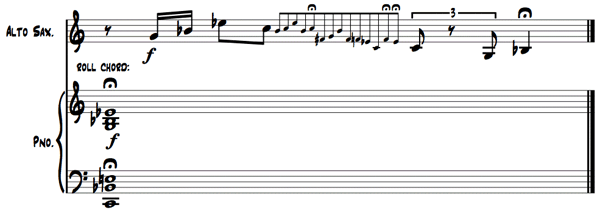
Everyone hears that as the tonic. What would Beethoven have heard, though, if he only heard that ending by itself? Would he even recognize it as being in the tonic key? He would probably hear it as something very strange—he would hear the piano chord there as a very dissonant version of a dominant chord that must resolve itself—in this case, to F Major. And it’s hard to imagine what he would make of the saxophone part—as a strange outburst, no doubt.
That type of saxophone flourish, which is more purely blues in nature, might not register as intelligible for Beethoven, but he wouldn’t have such a hard time with Bird’s long opening phrase that we first considered. He would hear the B-flat that ends the phrase differently than we do, though— namely as leading to the subdominant key of F that is approaching in the fifth bar of the solo, at bar 18. We hear that as well, but we also hear the blues in that B-flat. With our ears steeped in the blues and centuries of Western music alike, we can have these two simultaneous conversations with Bird. That B-flat is so alluring and exciting when Bird lands on it because of its dual meaning. It’s like a great actor appearing on the stage who wears the garb of a nobleman fresh from a visit to the court but adapts the speech rhythms of a twentieth century hipster. We are surprised and delighted because we respond naturally and easily to both of these musical tropes, but have not expected them to inhabit the same character.
The blues for Bird begins as something authentic and independent of traditional Western music theory, but with Bird’s mastery of harmony and inventive melodic approach, the blues also becomes one of several means of chromatically enriching the simple 12-bar schema. Looking at the opening line of his solo again,

we see that Bird is also using that be-bop scale with both sevenths in the second bar over the implied F subdominant tonality. The be-bop scale shows its effectiveness in a different light: It gives the players in the band—soloist and accompanying pitched instruments alike—a cue of sorts to chromatically thicken the texture. This isn’t willy-nilly chromaticism, though. Bird’s E-flat and E-natural in that second bar both easily attach themselves in our ears to the last notes of that bar, the C and the A, to create chains of relatively consonant third intervals. Many of Bird’s great lines form themselves by linking a major or minor triad to a passing tone that is half a step away from one of the notes in the triad. Bird joins something stepwise and something triadic:

In this way, Bird—like Bach and all the great conjoiners of melody and harmony before him—strongly denotes “vertical” harmony within a mere single-note horizontal melody: The outlined triads strongly suggests a harmonic progression, but the stepwise motion of those passing tones gives the line a melodic suppleness and keeps it from being mere glorified arpeggiation.
Bird’s continuing pervasive influence on the jazz vernacular is not merely because he joined together triads and scales to form his lines, though. It really rests on the way in which he codified that conjoining into a style that was so appealing in its plasticity. In that regard, it’s instructive to compare Bird with another innovative contemporary of his, the tenor saxophonist Don Byas. Byas was often more harmonically adventurous than Bird, arpeggiating further outwards from the triad, creating lines that effectively traced the piquant harmony of modern jazz, with its characteristic dominant seventh, ninth, and eleventh chords in their various permutations. But Byas, like Coleman Hawkins before him, is ultimately more literal than Bird—we hear the shape of a chord easily in his lines; he does not transcend arpeggiation in the way that Bird does.
There is nothing wrong with arpeggiation in itself, but Bird’s transcended that literal quality, and the less literal one is, the more possibilities remain. To demonstrate that further, let’s look at Bird’s opening line and imagine that he has a slightly hipper piano player comping behind him. This time we’ll give him some rhythm as well:
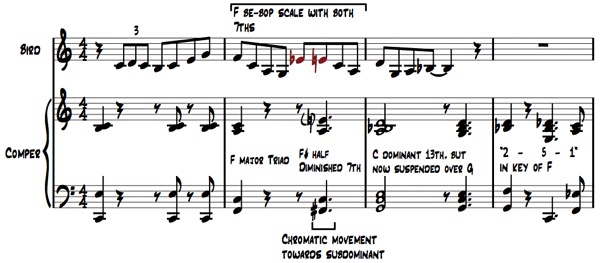
The pianist has gotten bolder in the second bar by inserting a half-diminished chord between the F triad and the C dominant thirteenth chord that follows. The F-sharp bass note then moves naturally upwards in scalewise motion towards a G in the third bar, instead of simply jumping back from F to C. (We can just as easily imagine this bass movement being supplied by the bass player in the rhythm section; I keep it in the piano part here just to show it on one stave.) This move to G in the bass is less clumpy and more sexy and sophisticated, but it is also more discursive in that way we mentioned earlier—it thickens the plot and packs more tension into a smaller amount of space.
We now have a bluesy descendant of the second inversion triad in the piano chords at the third bar, which, in the high Classicism of Mozart, Haydn, or Beethoven, is associated with the final climactic tutti utterance from the orchestra in a concerto, directly followed by a cadenza from the soloist that ends the movement with a flourish. The second inversion in both cases transmits a quickening and delayed gratification all at once. The message is that you’ve arrived at your destination—the tonic chord—but will just have to sit tight for a moment and merely gaze at it longingly. In the Classical concerto, the second inversion tonic will come back once more at the end of the cadenza, head to the dominant—already stated in the bass—and then finally resolve to the tonic to end. In the case above, that G in the bass leads us to one of the stock jazz progressions, the famous 2-5-1—that 1 being the new 1 of the F tonality of the fifth bar as the solo continues. And so we have what is long since a normative gambit within the first four bars of a 12-bar blues, brought to you by Charlie Parker.
That F-sharp half-diminished chord from our hipper piano player works quite nicely with Bird’s line, but the interesting thing is that the simpler F dominant seventh chord that the first imaginary comper played also worked just fine. Both accompaniments are already immanent in Bird’s line, which, with its E-natural and E flat, allows for both of them. This is the freedom of Bird on display—his lines sound unshackled in a way that no one else’s do because of they are so ripe with harmonic possibility. The pianist and other members of the rhythm section are likewise “free”—free to choose any number of hip ways of getting from Point A to Point B.
So, the E-flat in that second bar of Bird’s solo is a blues impulse, but paired with the E-natural, the blues is also felt as chromatic enrichment in the way it densifies the harmonic texture. We still have our 12-bar format; we still go from the tonic to the subdominant back to the tonic in the first four bars, but our journey is more involved. The emotional effect from all this on the listener, I think, is that Bird’s nuanced chromaticism brings romance to the music.
One way to think about this is through the metaphor of color. When a harmonic progression is less chromatically enhanced, the colors remain primary; when it is enhanced as in the example above, they become more pastel. Likewise, as those colors become more pastel, the emotions conveyed are increasingly complex; namely, there is the possibility to convey mixed emotions. Sentiment is less simple; we do not only hear the “primary color” emotions like joy and sorrow, but we also things like longing, wistfulness, and regret. Irony steps forward.
Admittedly, I’m putting forth a subjective reaction to the music, but Bird’s deeply beautiful long phrase that runs from bar 66 through bar 69 tells us all about longing and regret. To close, we look at the final chorus again of his solo that contains that phrase. I’ve inserted chord symbols to represent what the piano player comps for Bird. The piano player is none other than Bud Powell.
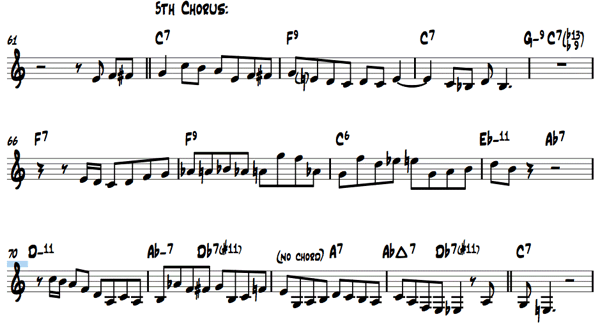
Bird’s first long phrase is feminine in nature. It is willfully naïve and simple, but almost trite. In bars 61 and 62, he is courting a cliché but then backs away from it. Bud, though, gives us the blues unquestionably in his dominant seventh and ninth chords. The way Bird’s pretty B-natural rubs against Bud’s B-flats is a great example of how be-bop should work—both players are free to approach the blues in different ways, and the tension they create in doing so is compelling. Bird’s next line from bar 66 through 69 is the kind of phrase that separates him from all his imitators—it’s so full of harmonic possibility; it suggests so much. When I look at it now and play it, it seems to suggest this kind of harmony:

I’m following the chromatic descent that Bird suggests in his line. The result is a variation on a progression that you hear on any number of tin-pan–alley tunes like “Candy” or “I Can’t Believe that You’re in Love with Me.” It’s romantic; it’s sweet. In itself, it was already nothing new at all when Bird arrived.
That kind of progression—not explicitly stated, but immanent, if you will, in Bird’s line, becomes something new when it rubs against the blues, which Bud Powell makes explicit in his comping: He bypasses that chromatic descent and stays mostly with dominant chords in the first eight bars of this chorus. The tension that arises when the craggy blue notes and sweet “white” ones rub against each other is subtle and thrilling. Does this have a name in music theory—besides “wrong”—when one person plays major intervals and another plays flatted notes directly against them? Is it a kind of suspension? That it’s something chromatic is about all we can say, and it works best in praxis. We can forensically examine Bird’s playing with his groups and maybe establish a method, but it is, as the writer Italo Calvino remarked in the context of literature, “a method subtle and flexible enough to be the same thing as an absence of any method whatsoever.”
At the risk of using a bandied word, Bird’s blues is deconstructive, meaning that it critiques traditional functional harmony and engages with it at the same time. Jazz music in Bird’s representative oeuvre is a marriage of romance and the blues. The blues becomes precious, and romance loses a bit of its preciousness.
 In these segments, we’ve been considering the benefits and limits of a three-period model when applied to Beethoven and Coltrane. Before I go back to Coltrane for the next and last post, we should ask, after all this discussion of Bird’s innovation: Is Bird like Coltrane or Beethoven? The way I see it, no. Bird did not reach a third phase. He never transcended his own mature style for a second time. His early death leaves the question open as to whether his playing would have significantly changed again. There are some fascinating early recordings, for example, of Bird as a soloist with the Jay McShann’s band that might constitute a kind of first period of Bird’s, but not in the same way that we have been understanding Beethoven’s and Coltrane’s first periods. To clarify: The first period of Beethoven—which includes his six Op. 18 string quartets, the three Op. 2 piano sonatas, the early piano trios and his first two symphonies—and the first period of Coltrane—which includes his recorded work in the bands of Miles and Thelonious Monk as well as numerous dates for the Prestige label under his own name—are canonical in their own right, independent of what Beethoven and Coltrane subsequently achieved. Their first period output captures our imagination on its own terms; it is fully realized and we make no concessions in listening to it.
In these segments, we’ve been considering the benefits and limits of a three-period model when applied to Beethoven and Coltrane. Before I go back to Coltrane for the next and last post, we should ask, after all this discussion of Bird’s innovation: Is Bird like Coltrane or Beethoven? The way I see it, no. Bird did not reach a third phase. He never transcended his own mature style for a second time. His early death leaves the question open as to whether his playing would have significantly changed again. There are some fascinating early recordings, for example, of Bird as a soloist with the Jay McShann’s band that might constitute a kind of first period of Bird’s, but not in the same way that we have been understanding Beethoven’s and Coltrane’s first periods. To clarify: The first period of Beethoven—which includes his six Op. 18 string quartets, the three Op. 2 piano sonatas, the early piano trios and his first two symphonies—and the first period of Coltrane—which includes his recorded work in the bands of Miles and Thelonious Monk as well as numerous dates for the Prestige label under his own name—are canonical in their own right, independent of what Beethoven and Coltrane subsequently achieved. Their first period output captures our imagination on its own terms; it is fully realized and we make no concessions in listening to it.


Comentários